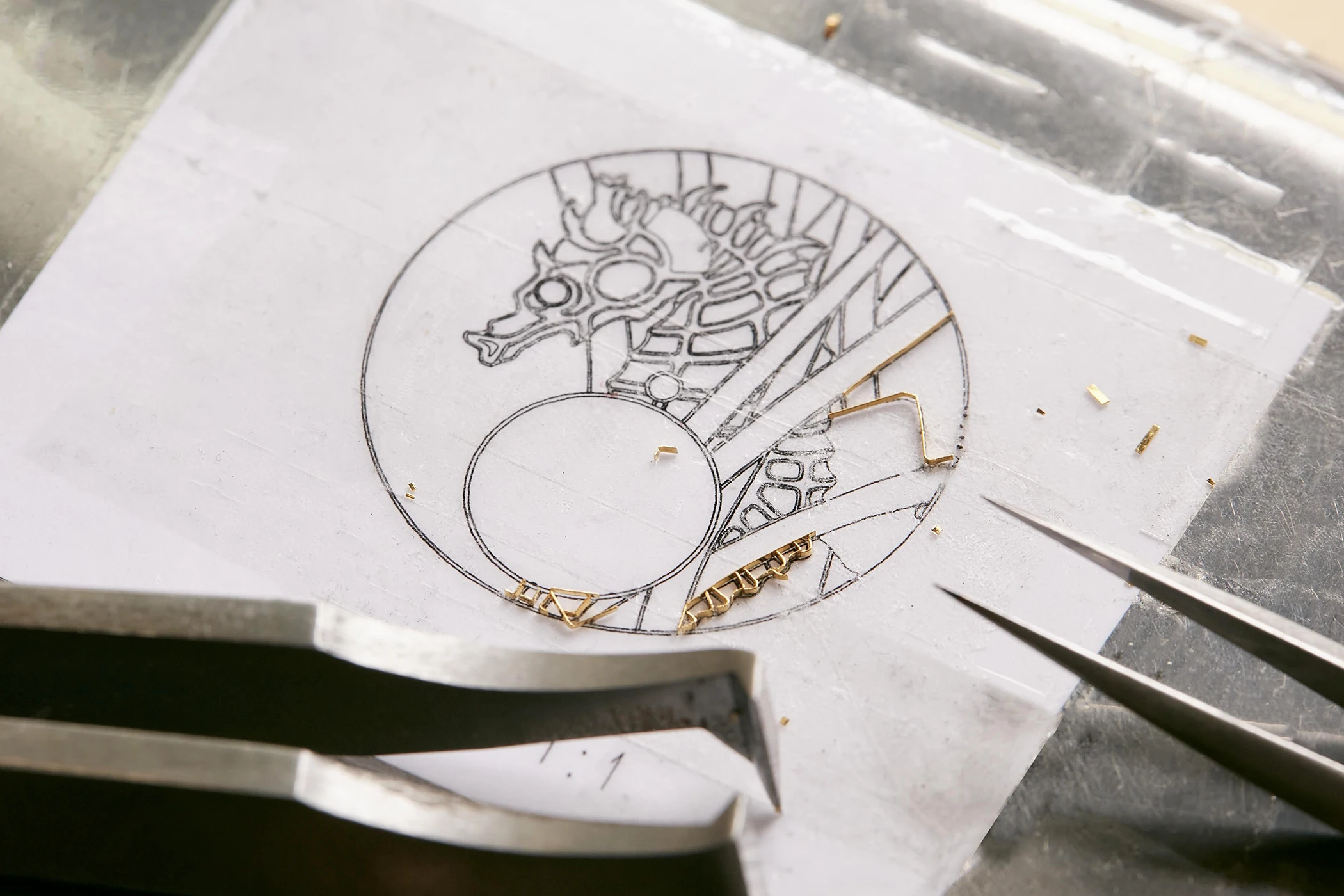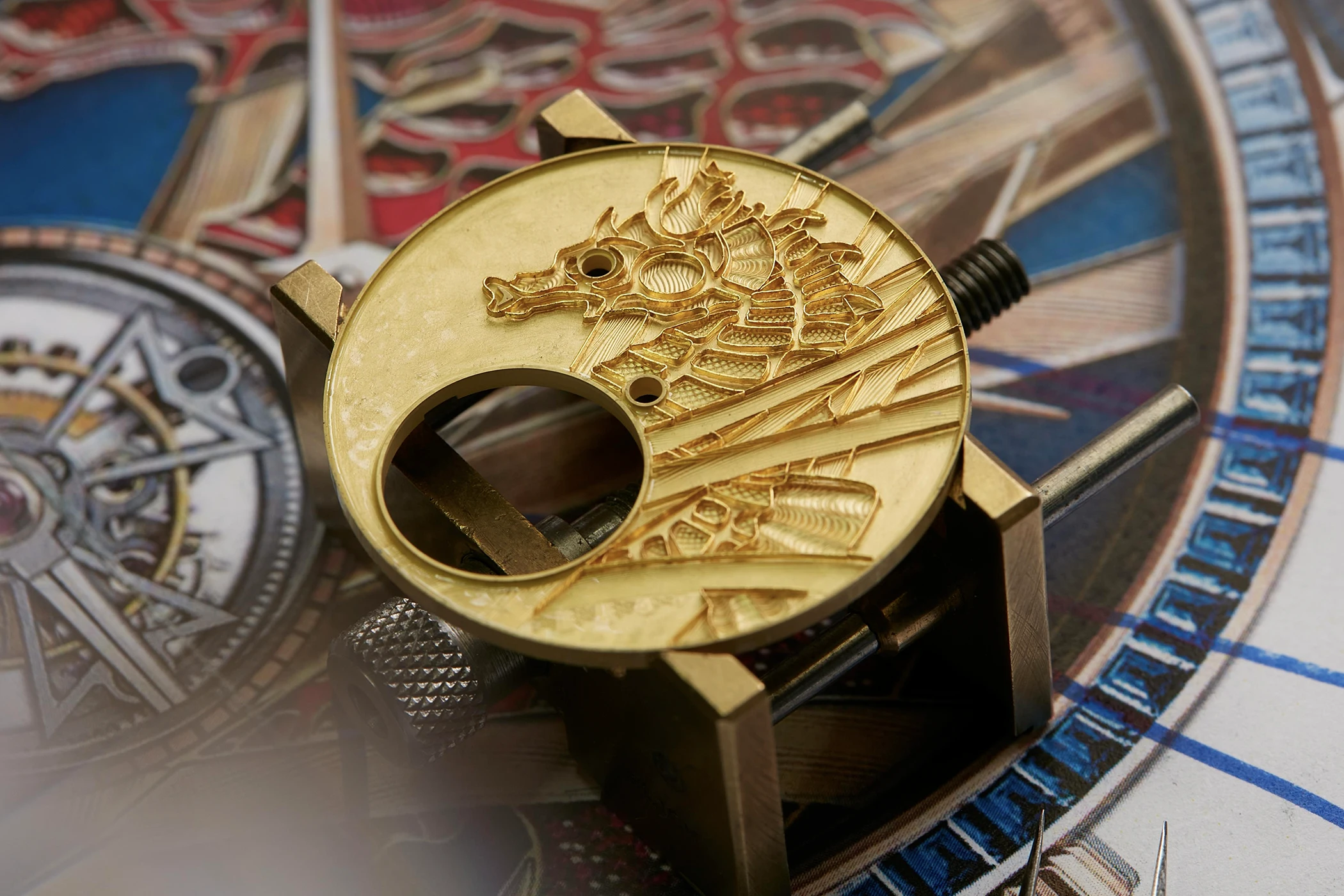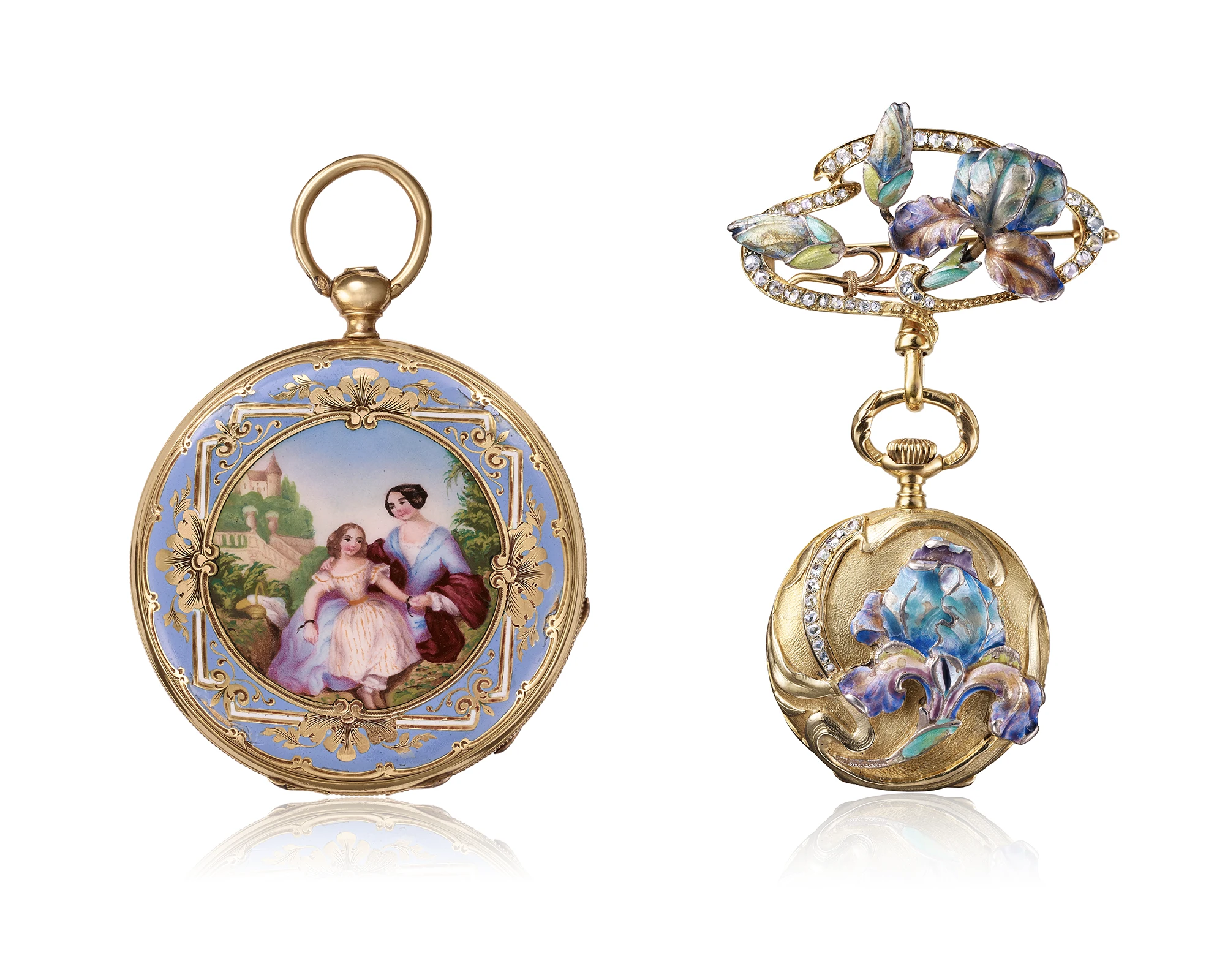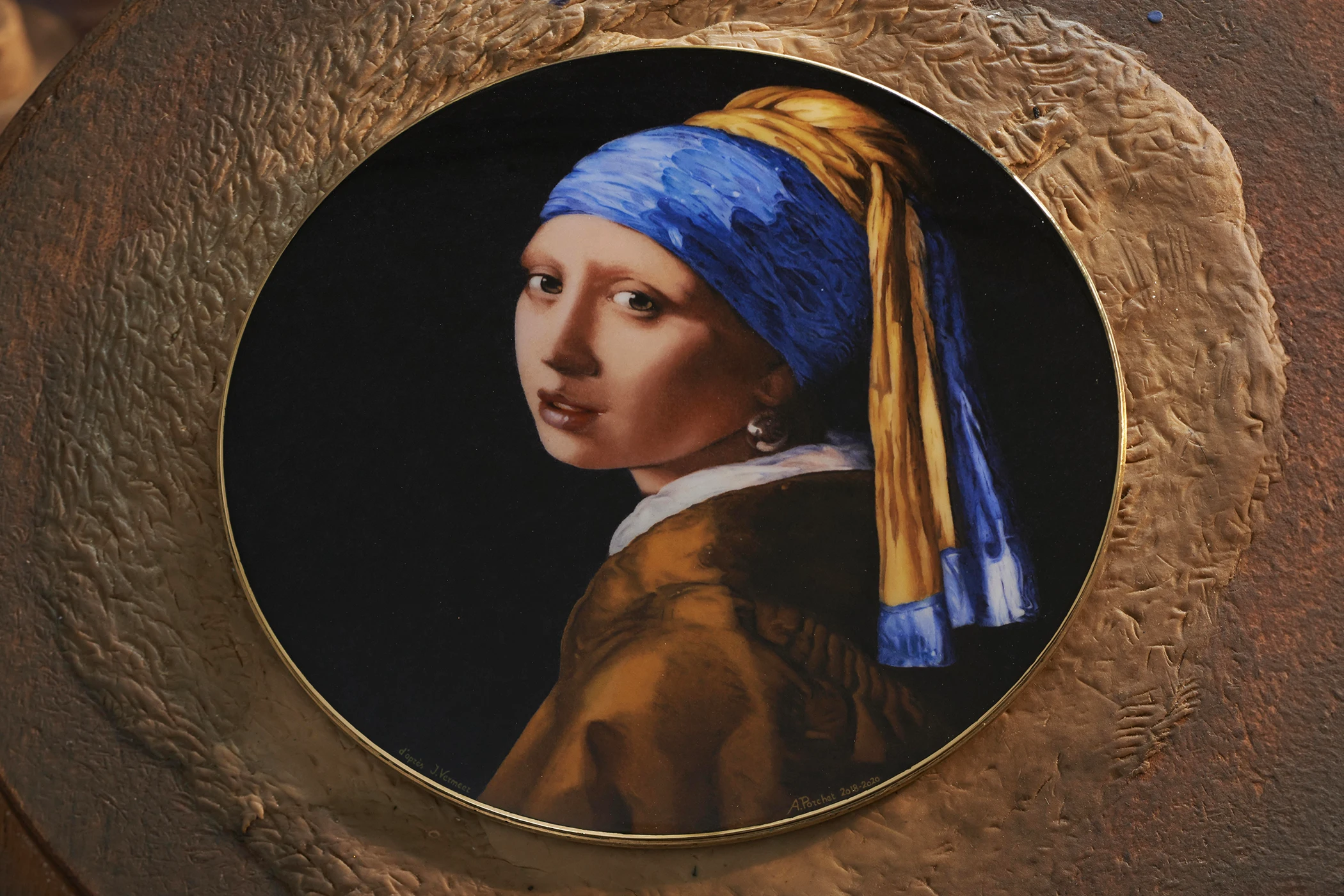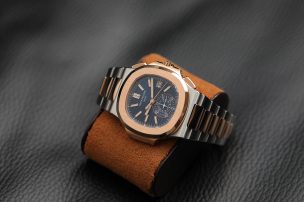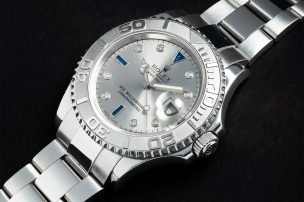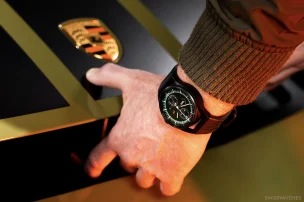
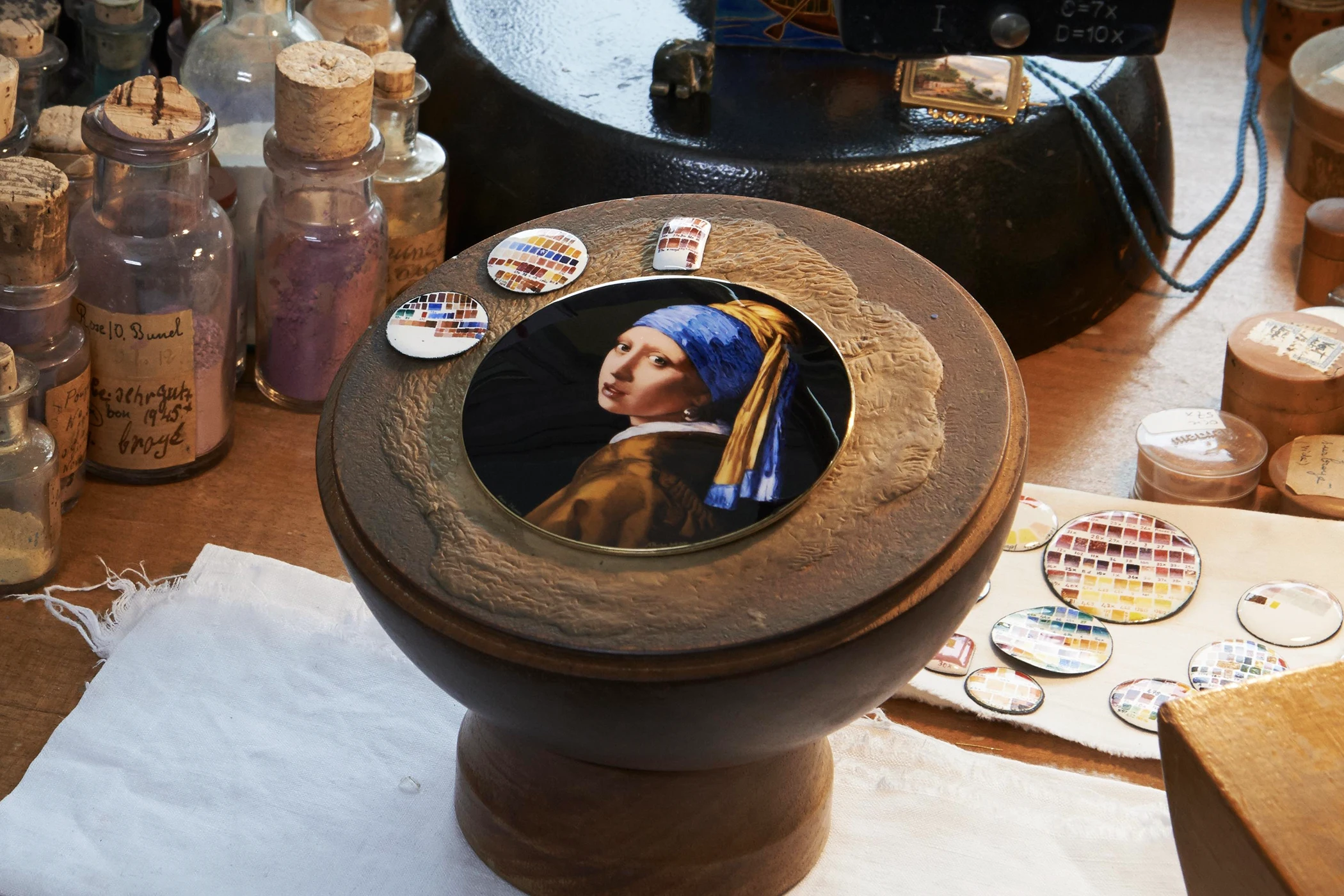
Vacheron Constantin Is A Master Of Enamelling – An Exploration Of A Rare Artisanal Craft
Is the currently weak watch market perhaps lacking the sophistication to truly captivate top collectors who already have everything? Editor and watch expert Jörn Kengelbach embarks on a journey into the world of Vacheron Constantin’s enamel craftsmanship — and explores why this rare art could play a key role in the watchmaking industry’s spectacular comeback.
A world of its own
Those who first explore the craft of enameling mechanical timepieces find themselves in perpetual awe. I have to admit that I have always steered clear of such craftsmanship for one simple reason: the wealth of information behind it would go beyond the scope of a single article, especially when it comes to the longest continuously operating watchmaker, Vacheron Constantin. In its 270th anniversary year, the Maison offers a timely opportunity to delve into this extraordinary world.
Telling the time? Works of art!
While it may seem today that mechanical wristwatches were created purely to measure and display time with precision, this view greatly distorts what watches — and especially pocket watches — represented for centuries: valuable items that, of course, enabled their owners to tell the time with reasonable accuracy (As precisely as a member of the aristocracy has had to since the Renaissance. After all, all their subjects were guided by their every move.). But above all, pocket watches emphasised social rank, style, and ultimately also expressed their owner’s wealth. And the enamel work on the dials, and even more so on the cases and bezels of early watches, contributed to all of that for a simple reason: because these components have always given watches a face.

A complete archive and an expert to guide us
With 270 years of history, Vacheron Constantin boasts the most extensive archive of any watchmaking company in existence – and until the early 20th century, it was the most coveted brand in the world among royalty, popes, and generals alike. Therefore, it is in many ways worthwhile to explore this universe together with the Maison.
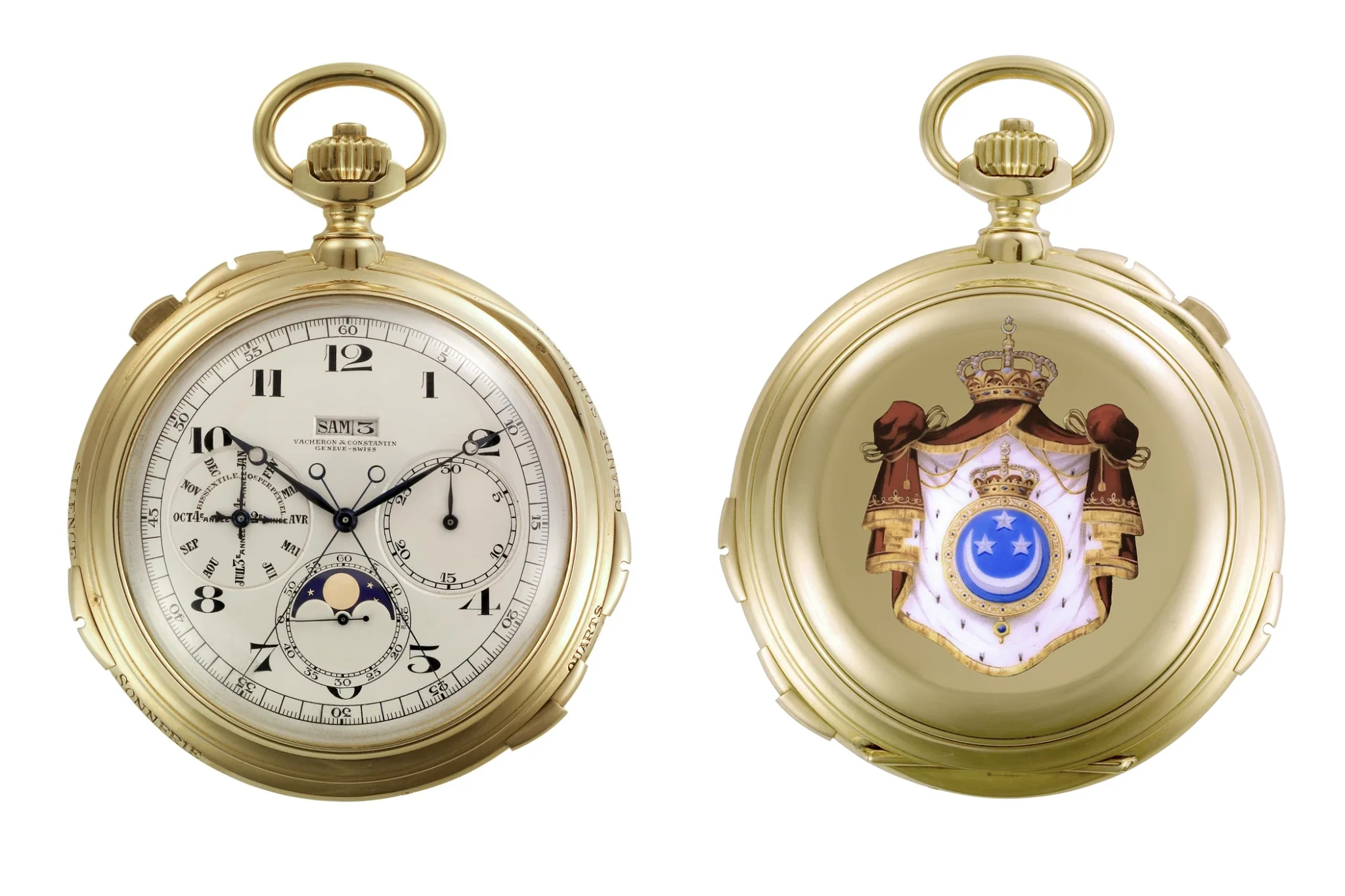
Guiding me through this adventure, I have Christian Selmoni by my side. He has been with the company for 35 years. Moreover, he has already been responsible for the collection for the 250th company anniversary, designed the comeback of the Overseas and is now in charge of the 222. As Vacheron Constantin’s Style and Heritage Director since 2017, he is probably more familiar with what this company is capable of and what it has achieved throughout its rich history than anyone else.

Where did the combination of enamel and watches originate?
Let’s start with the basics: the first known enamel works are around 3,500 years old and were used as grave goods in Mycenaean tombs in Cyprus, which anyone can read on Wikipedia. It shows that enamel work has always been held in high regard and has been inspiring, because thanks to this technique particularly bright colours were able to last for centuries – which might not be trivial when you are moving into afterlife. Although enamel is sensitive to impact, it is a robust material that is almost chemically unalterable and does not lose its luminosity over time.
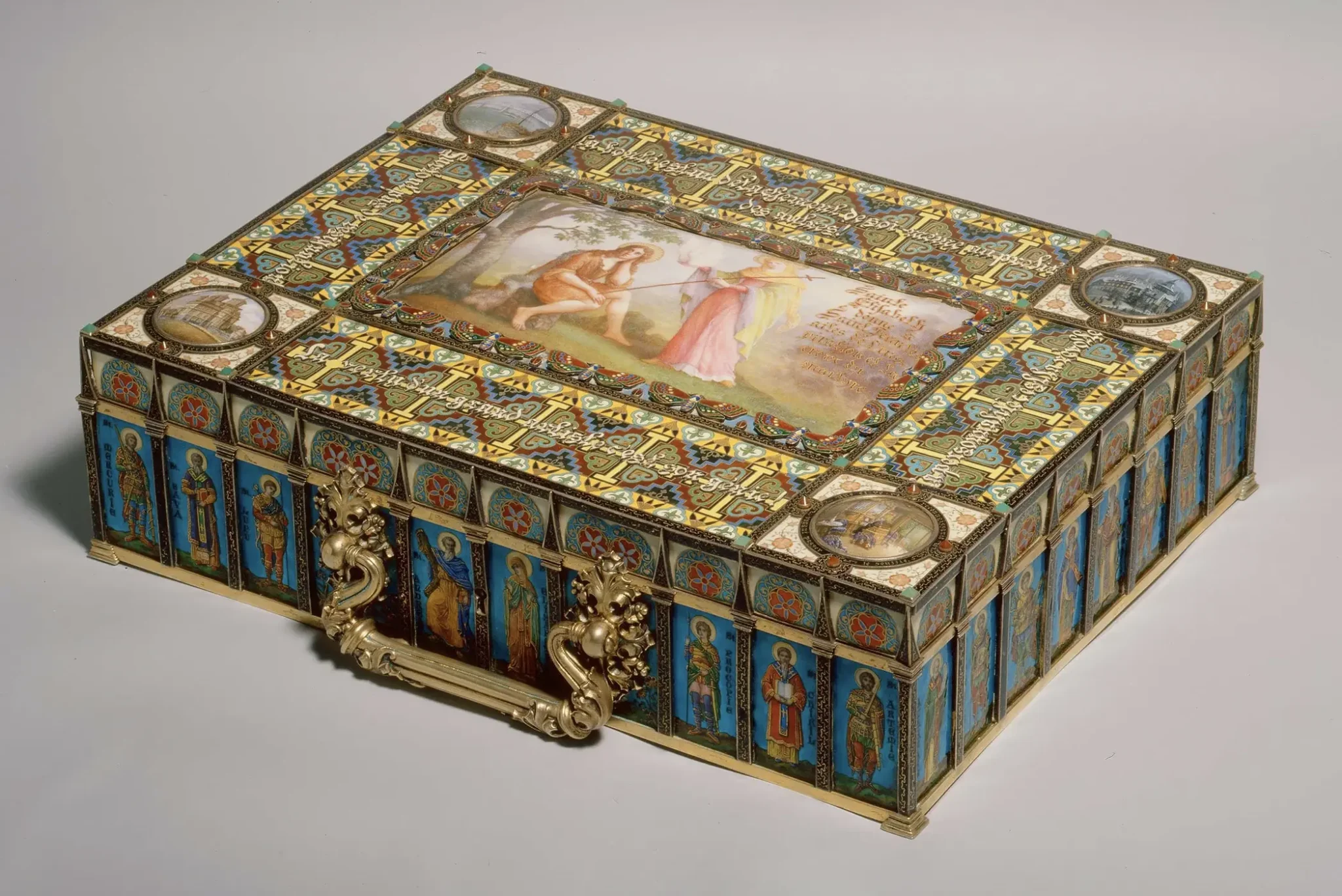
Credit © By Khalili Collections / CC BY-SA 4.0
From antiquity to the modern watch
In Geneva, this decorative technique first came into its own with the Huguenots in the mid-16th century, who had been expelled from France. They learned their trade in Paris but were no longer allowed to practise their religion.
As rare and as sought-after as good enamellers are today, it is hard to imagine that enamel work had been the predominant watch decoration technique for almost 300 years. In comparison to various engraving techniques, which we will discuss in another article, this technique prevailled between 1600 and 1900.
The modern wristwatch replaces the elaborate pocket watch
From the early to mid-20th century, lavishly decorated pendulum clocks, table clocks, wall clocks and pocket watches were replaced by the modern wristwatch with its much more limited expressive possibilities. Moreover, this art was neglected because watches, as everyday objects, were and are subject to completely different wear and tear.
Vacheron Constantin is preserving the decorative arts
From the late 1970s until the comeback of mechanical watches in the early 1990s, only few brands had been preserving this important tradition. Vacheron Constantin was one of them, as Christian Selmoni explains: ‘In fact, enamel has been present in our creations since the early years of the Maison.’
‘From the 17th century onwards, Geneva became a centre for delicate enamelling, particularly miniature painting in enamel, thanks to the invention of the “Genève” technique, which involves final firings with transparent enamel. Various enamelling techniques such as Champlevé, Cloisonné or miniature painting were very popular within our traditional ‘métiers d’art’. However, during the 1970s and 1980s, enamelling lost its appeal and almost disappeared entirely.’ Vacheron Constantin, however, continued to offer a few enamelled watches, which explains their desirability and rarity today.
We will return to the techniques he describes later, but it is important to note that the Maison proved that it definitely was a pioneer in the rediscovery of this precious craft through exceptional watches such as the ‘Mercator’ (1994) or ‘Birds of America Tribute to J.J. Audubon’ (1996).
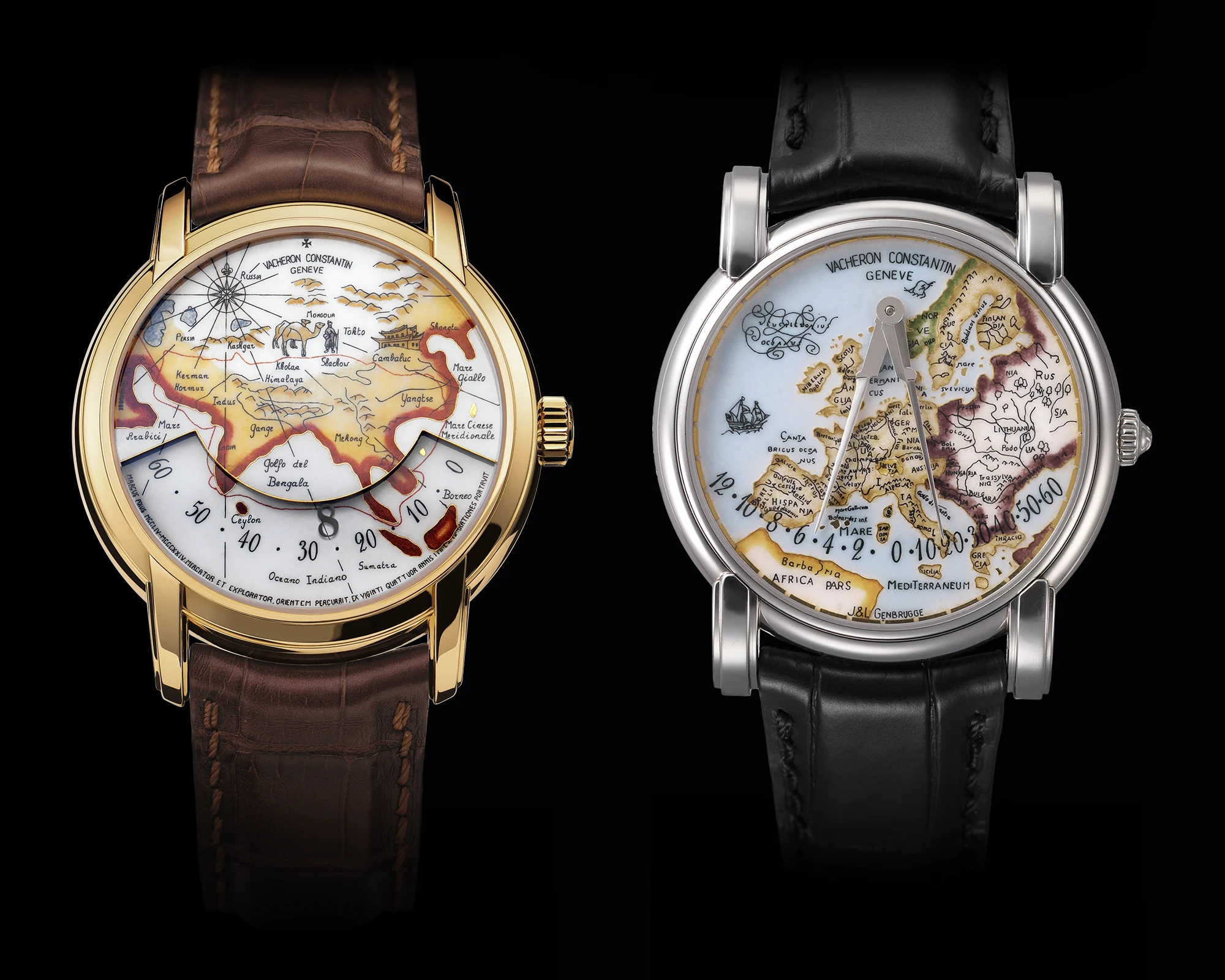
For Selmoni, there is no doubt that enamel has regained its status as an outstanding decorative art, which the Maison expresses through limited series such as the ‘Tribute to Great Civilisations’ (2022) and the unique pieces created by ‘Les Cabinotiers’, Vacheron’s unique pieces department.
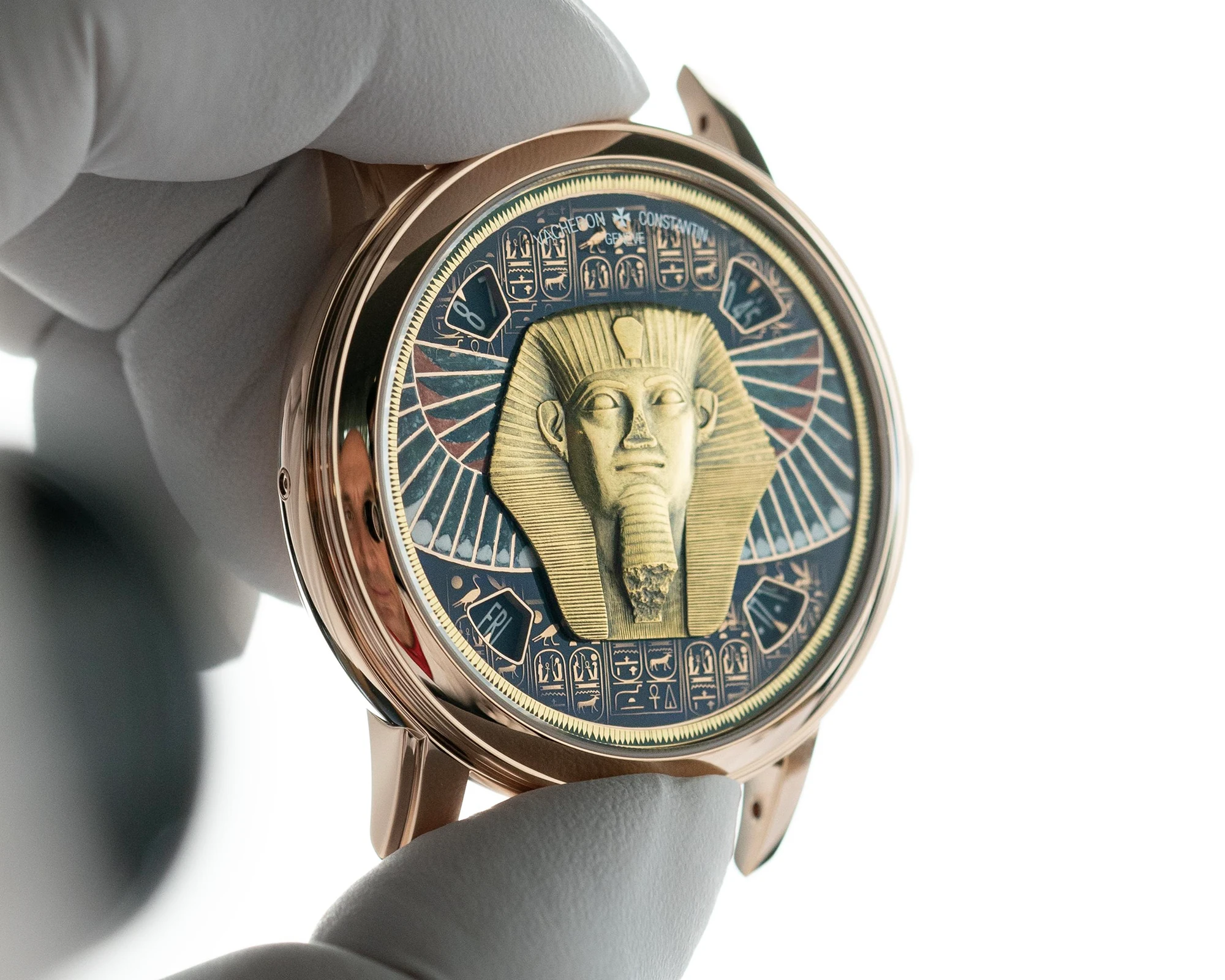
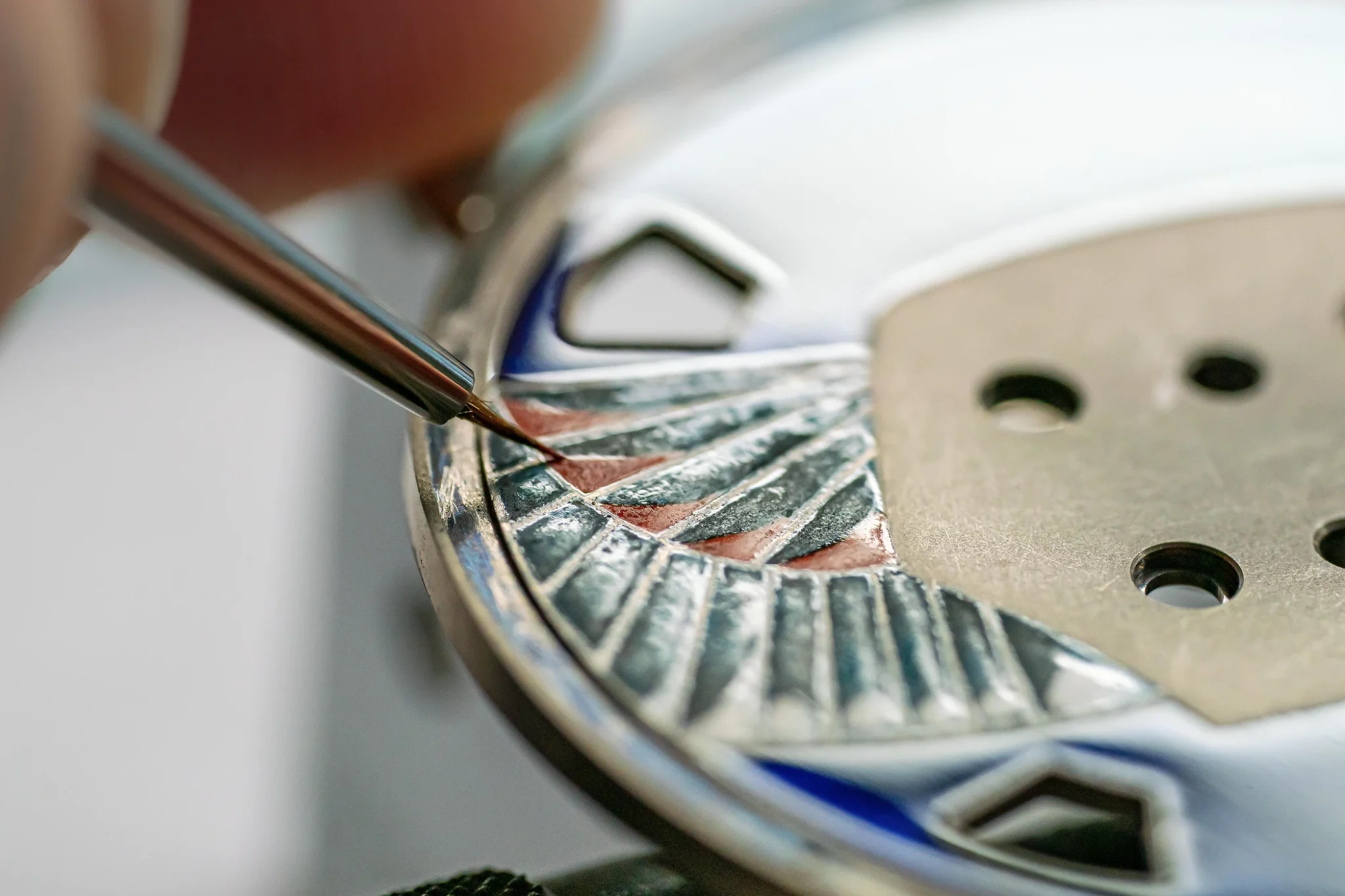
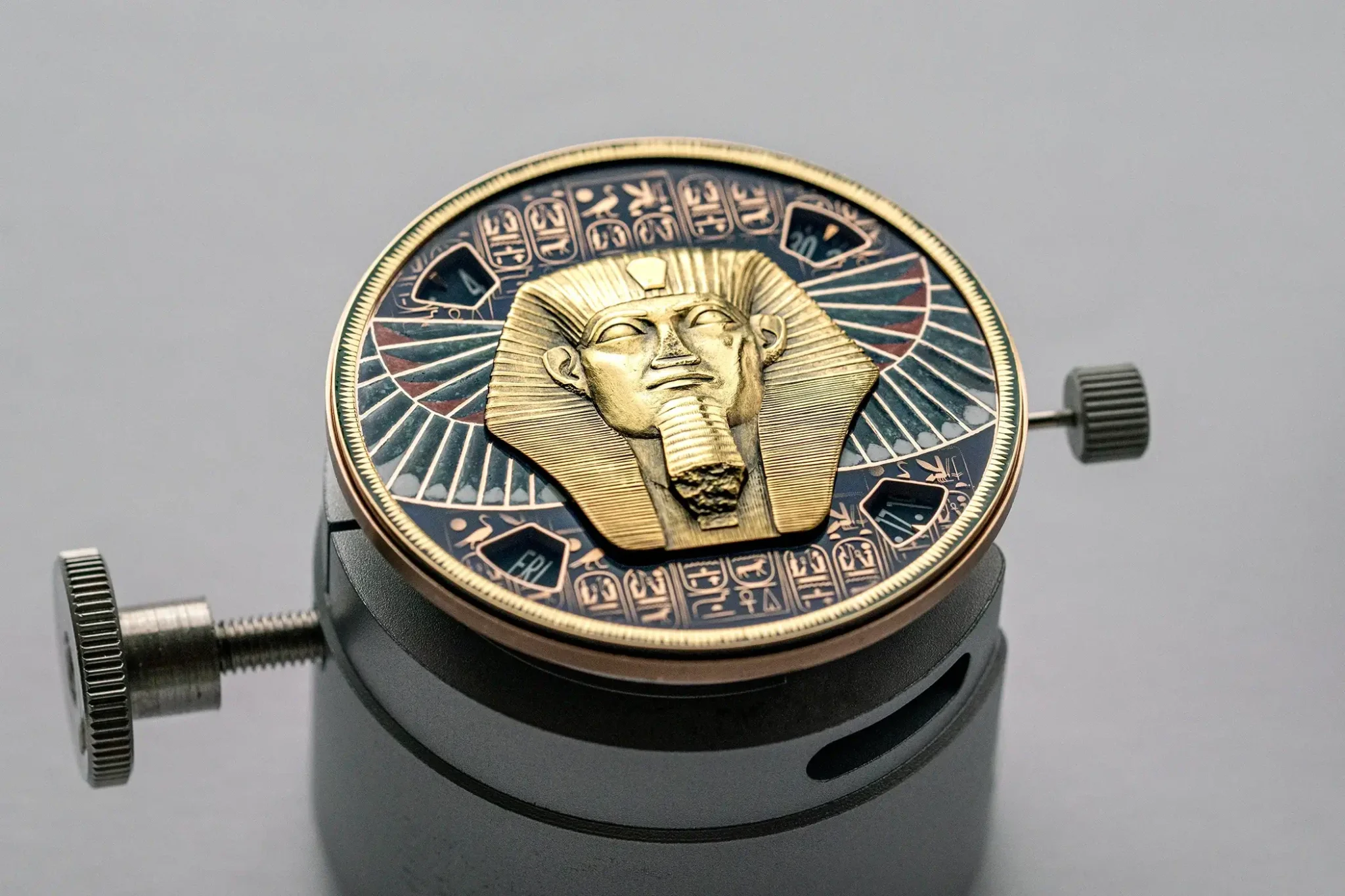
Exceptional pieces to mark the 250th anniversary 20 years ago
It is precisely in the ‘Les Metiers d’Art’ series that the Geneva-based manufactory has been celebrating its comeback for a good 20 years now, with exceptional enamel works to mark the 250th anniversary. Anyone leafing through Franco Cologni’s book ‘Secrets of Vacheron Constantin’ (highly recommended for collectors) on the occasion of this important anniversary will uncover a rich tapestry of techniques, an abundance of creations, and a wide range of styles, all of which demonstrate why Vacheron Constantin’s enamellers rightfully stand as a benchmark in the art of enamelling.

The best artisans in their field
While craftsmanship was often bought in as an additional service in the past, with famous names working for different manufacturers, things are different nowadays, as Selmoni further elaborates: ‘Since the early 19th century, our Maison has worked with the best artisans in Geneva – they were all independent. One decade after the rediscovery of decorative craftsmanship in the 1990s, we decided to found our “Métiers d’Art” workshop to preserve and pass on these traditional forms of craftsmanship and push back their boundaries. The workshop is dedicated to our four historical forms of craftsmanship: enamelling, guilloché, gem-setting and engraving.’
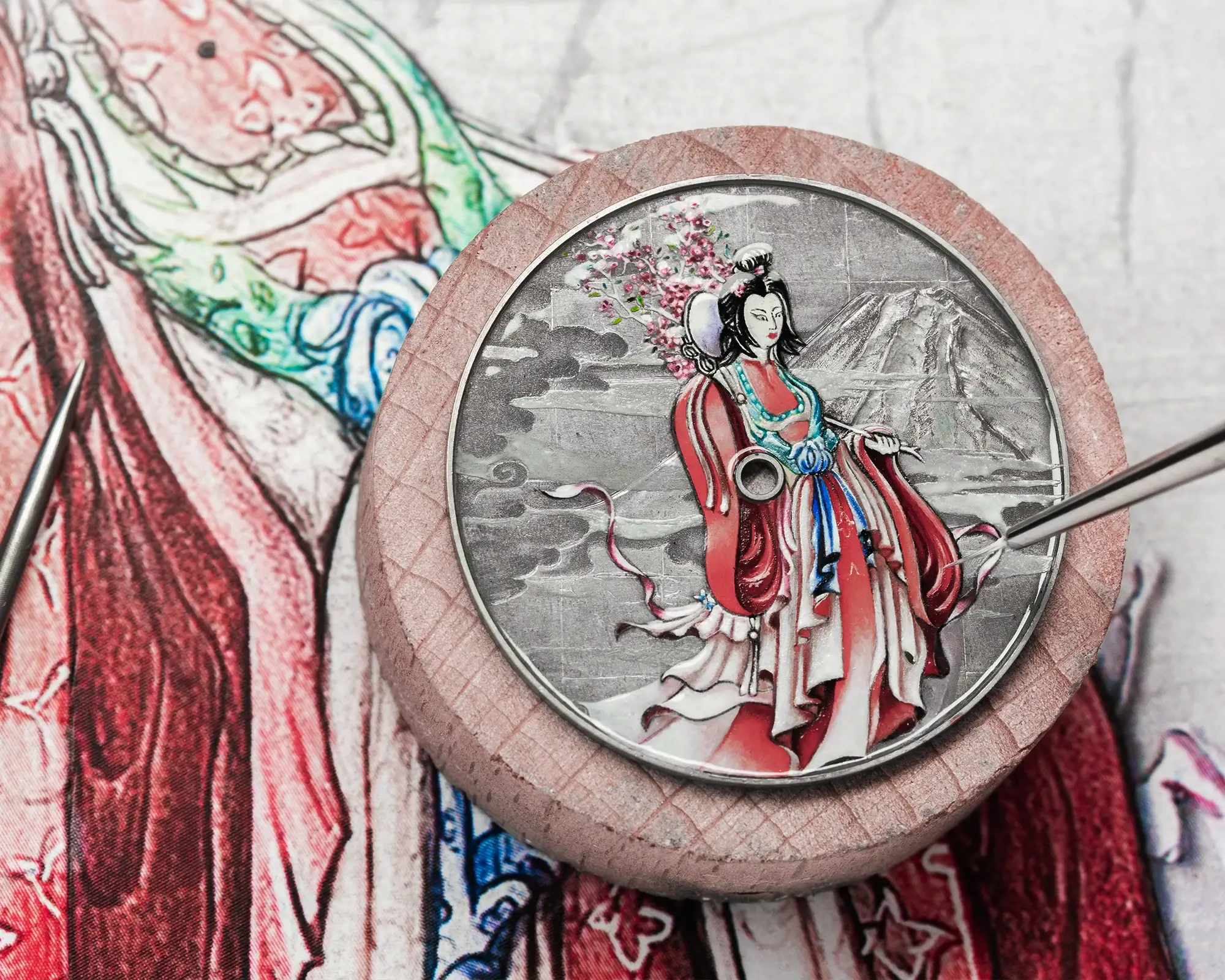
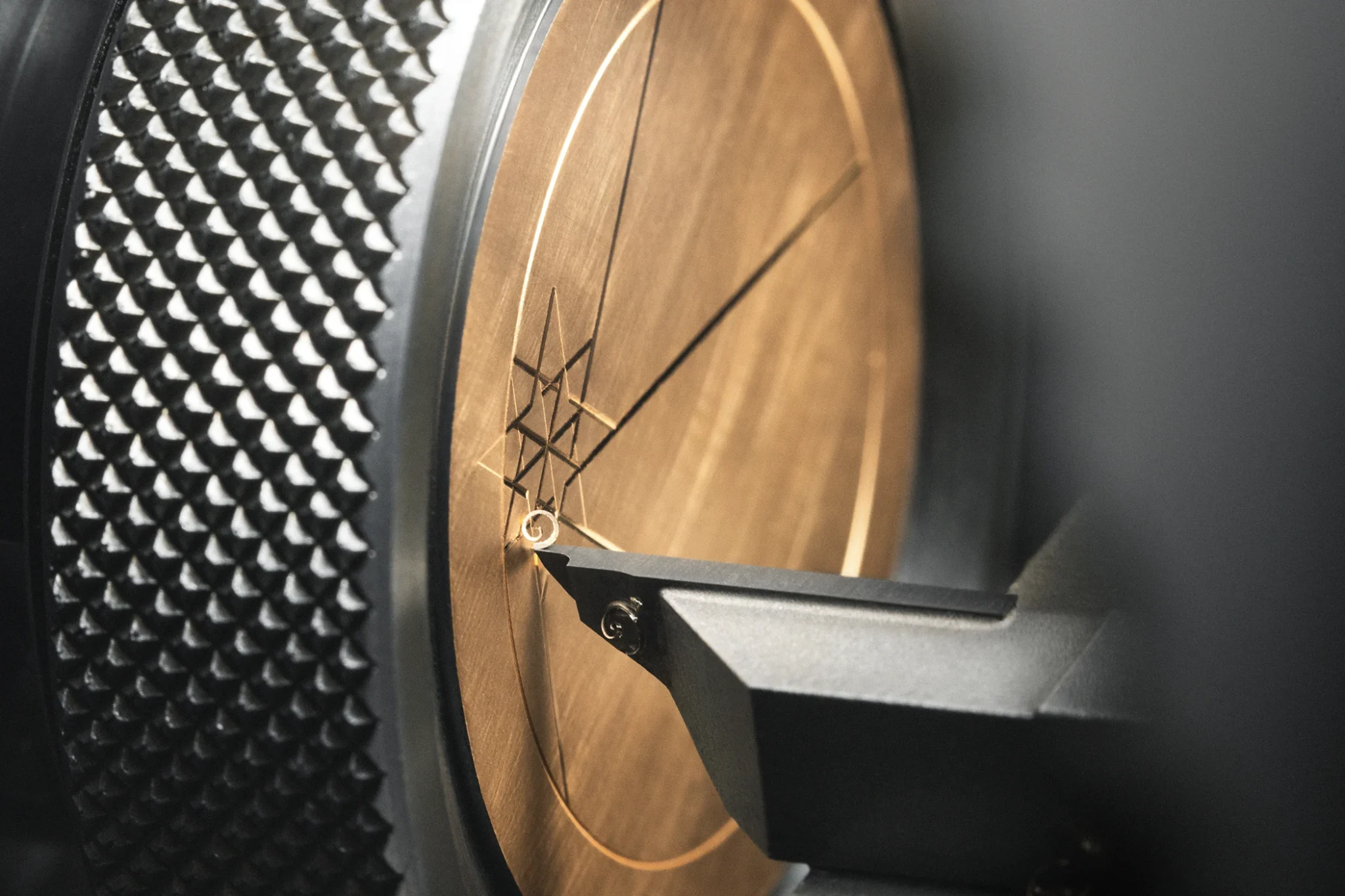

Which enamel techniques should collectors be familiar with?
Let’s move on to the enamel techniques that collectors should be familiar with. Once again, it is important to note that enamelling was by no means limited to the dial. For example, it was mainly used for the case, the case cover, and the bezels of pocket watches.

Champlevé enamel and cloisonné enamel
The two oldest types of enamel remain the most significant to this day. Originally, however, they were primarily favored for decorating watch cases rather than dials. How can you recognise these techniques? IIn both champlevé and cloisonné enamelling, the contours of the design are clearly defined and visible on the surface. How are motifs created using these techniques? For the champlevé or cloisonné grès technique, the engraver designs the drawing on a metal plate. The drawing’s contours are left out when hollowing out the areas that will later be filled with enamel.
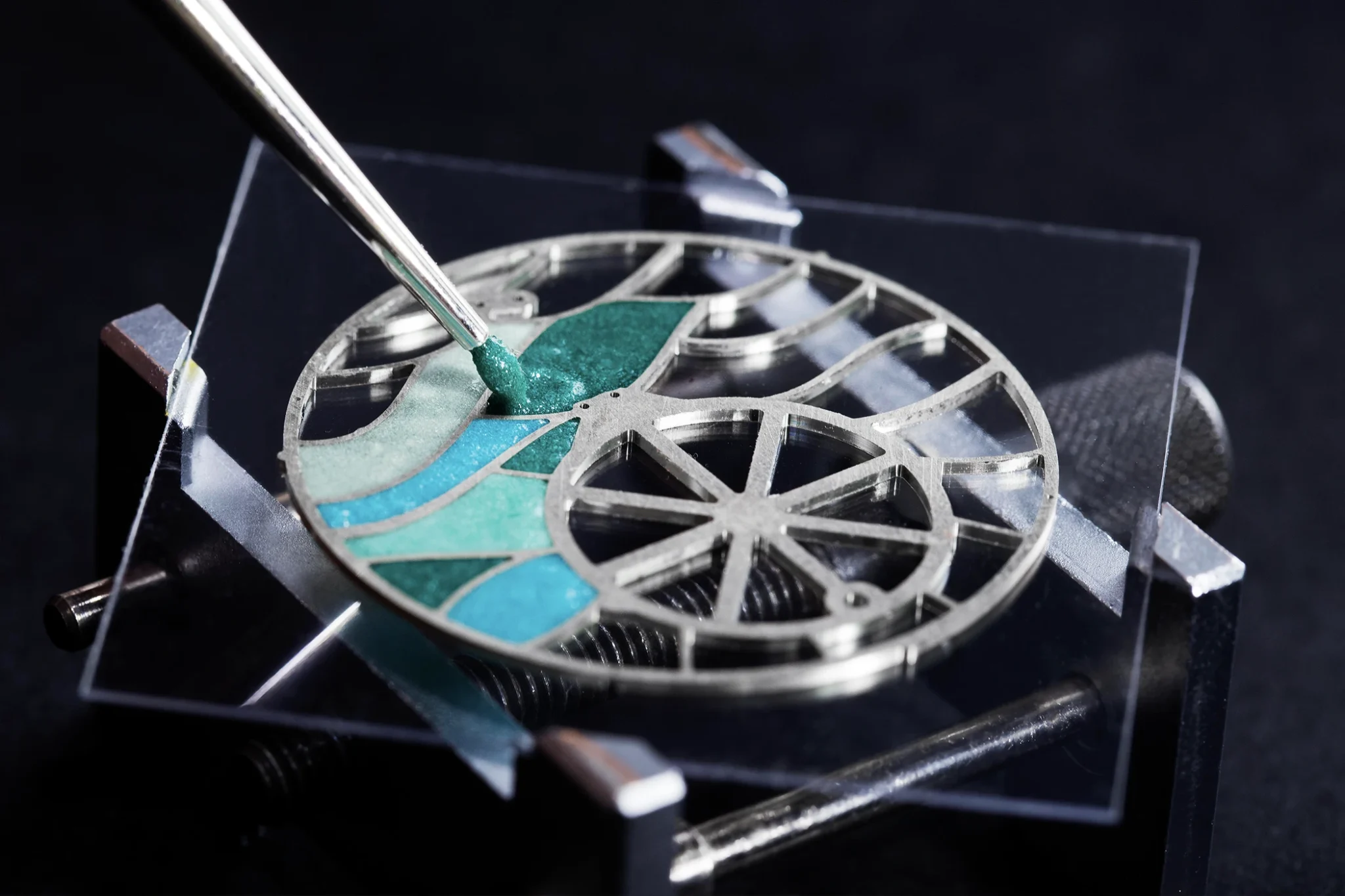
For the cloisonné, the artist glues a rectangular cross-sectioned metal wire structure to a base and adjusts it to the shapes of the desired motif. The walls thus constructed delimit the cells that will receive the enamel.

The basics of enamel
What is enamel? Enamel is a fusible mixture of various minerals to which metal oxides are added to produce colour. In Haute Horlogerie, enamel in powder form is applied to a metal base (copper, silver or gold) and fired in a kiln in several thin layers. The term ‘Grand Feu enamel’ is used when the enamel reaches its melting point at higher temperatures between 820°C and 850°C.
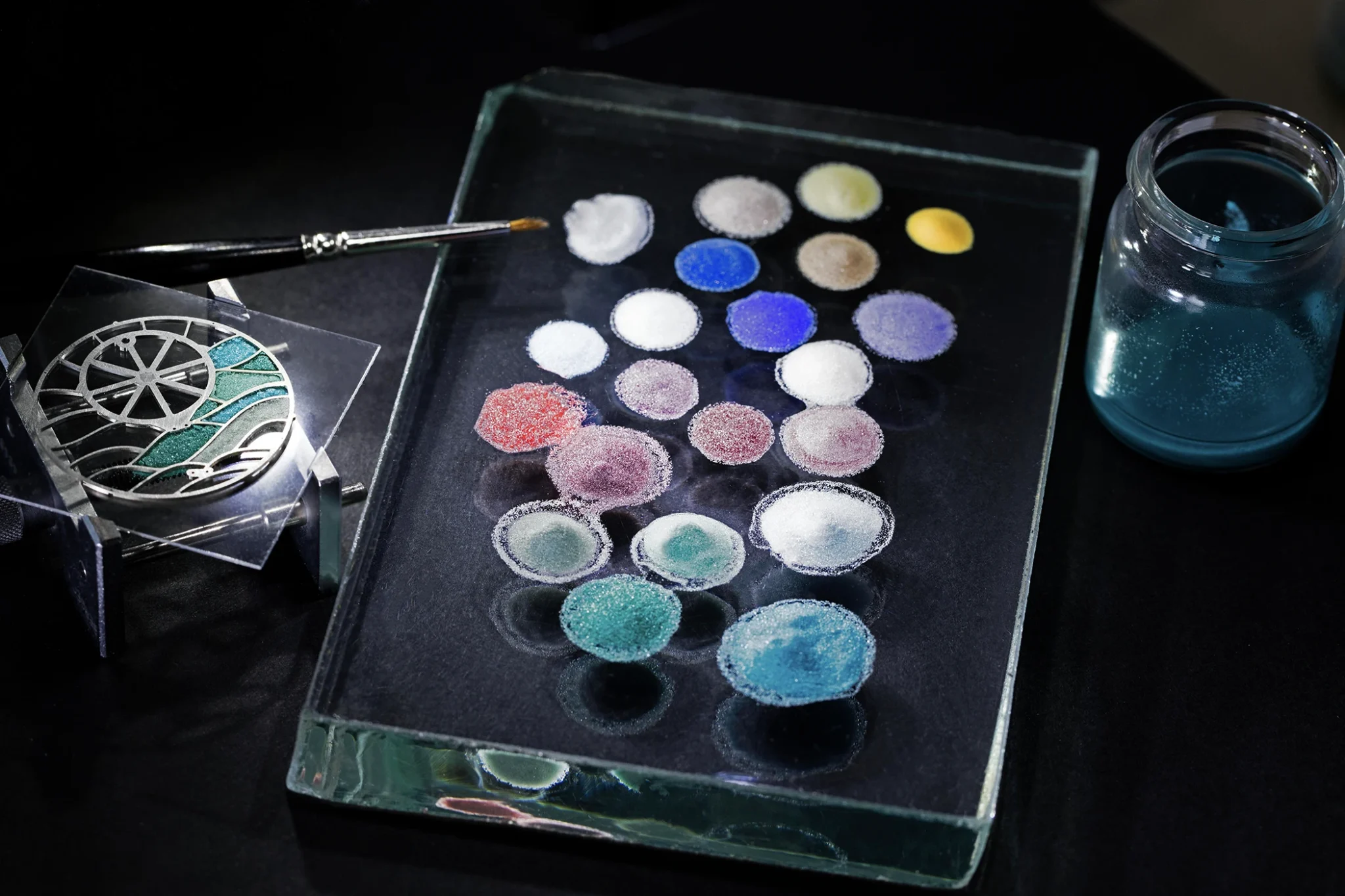
Champlevé (kiln-firing enamel technique) at Vacheron Constantin
The oldest known enamelling technique – featured notably on the four timepieces in the ‘Les Cabinotiers – The Singing Birds’ series – involves multiple firings at temperatures exceeding 800°C to melt the enamel. The surface is then carefully polished to level the material, followed by a final glaze that imparts both brilliance and a flawlessly smooth finish.
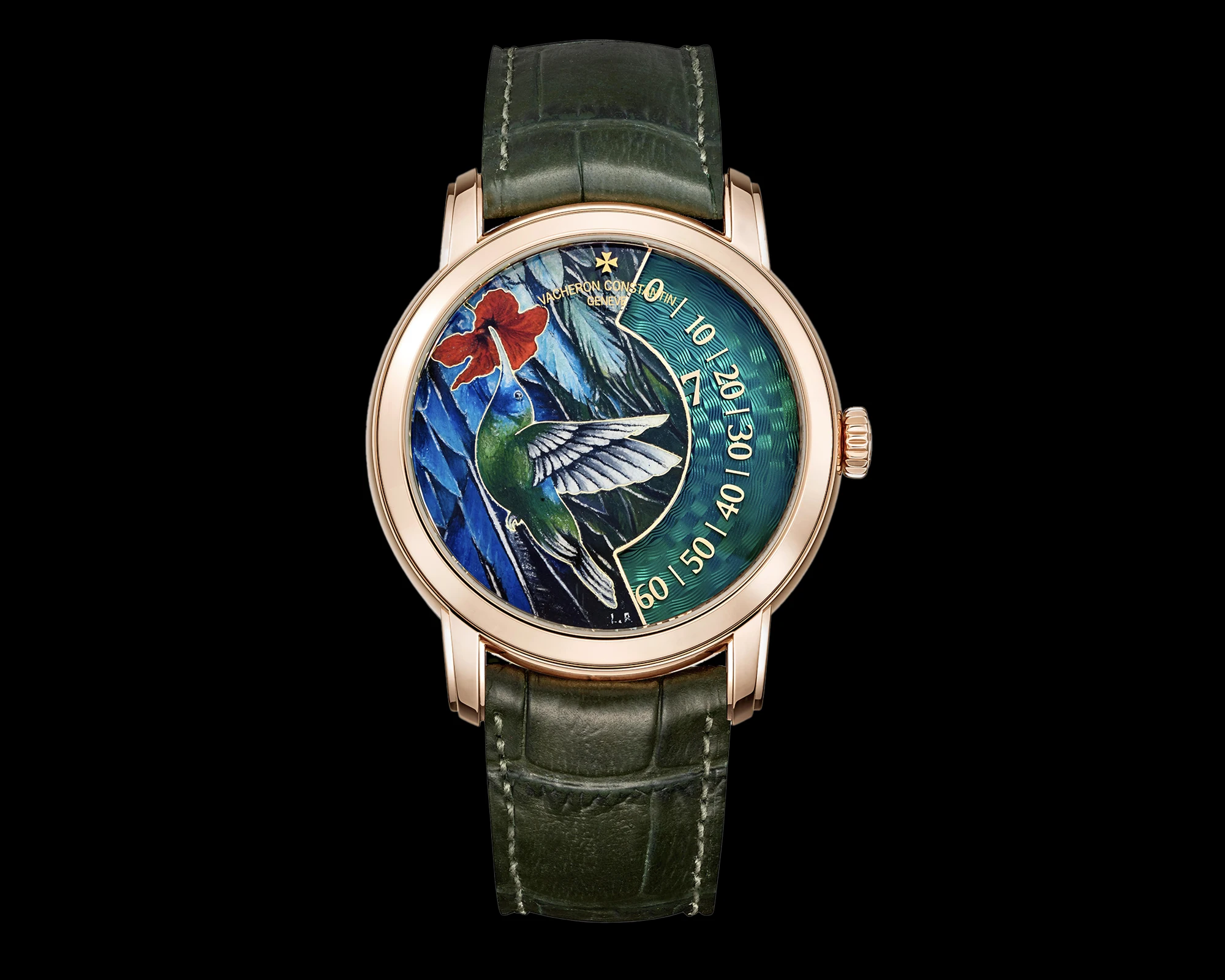
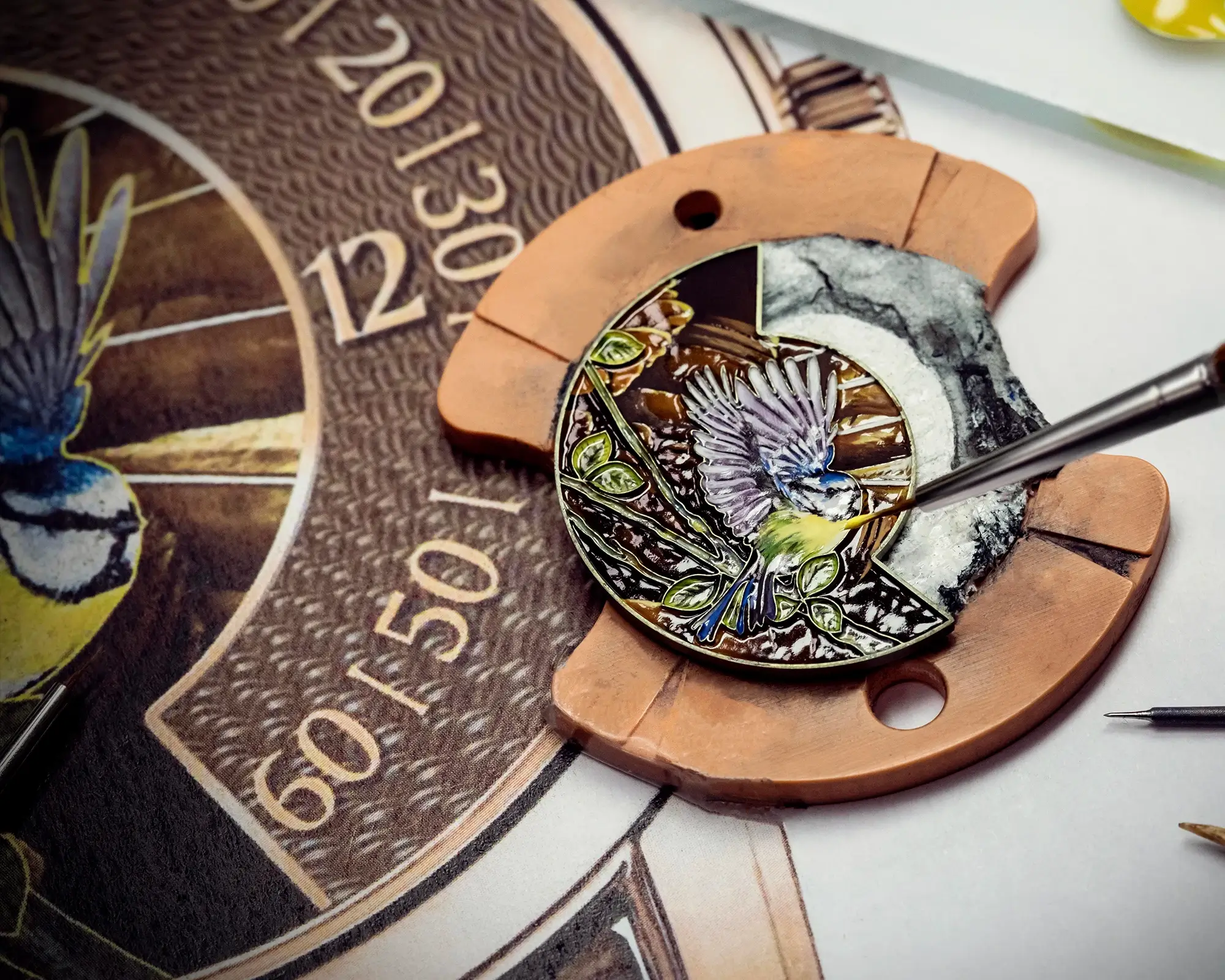
Cloisonné
The cloisonné technique involves outlining the design using fine gold or silver wires, which are affixed to the surface with a natural binder, often gum tragacanth. These delicate partitions create tiny compartments, or ‘cloisons’, which are then filled with enamel powder and fired in successive stages to build up subtle variations in shade and depth.
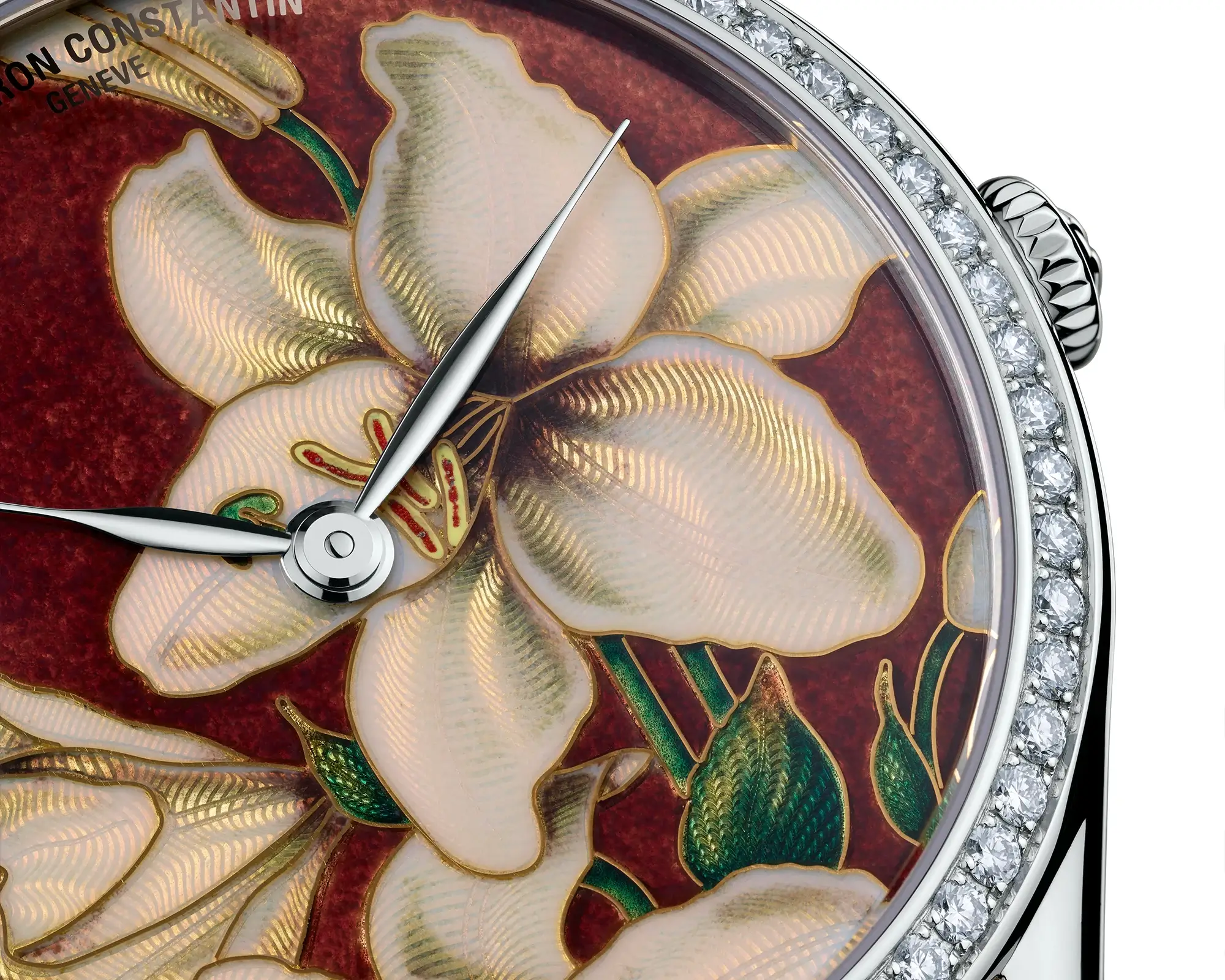
Incredibly ornate pocket watches
The incredibly ornate Vacheron Constantin pocket watches from the first half of the 19th century not only reflect the taste of the time. Here, champlevé and cloisonné enamel techniques merge with numerous leaves, scattering patterns, garlands or veritable bouquets to create the splendour of a long-gone era. The richly coloured palette often stands out against a black or intensely blue enamel background.
The five most important historical enamel watches in Vacheron Constantin’s history – according to Heritage Director Christian Selmoni
Though it’s a challenging question, I ask Selmoni to share five key historical highlights that readers should know when linking enamelling with Vacheron Constantin: ‘Selecting five watches from our history is a challenge, but let’s start with an extraordinary pocket watch from 1824, whose lid is enamelled with a map of Italy – a piece of infinite delicacy. From the Art Deco period, there are numerous examples of creations with enamel in a pure Art Deco style, such as brooches inspired by Chinese and Japanese motifs. In the 1950s, we also produced wristwatches with cloisonné enamel dials, such as the “Caravelle”. Later, in 2011, we launched “Univers Infinis”, a series that combines various types of craftsmanship, including champlevé enamel in a spectacular configuration.’
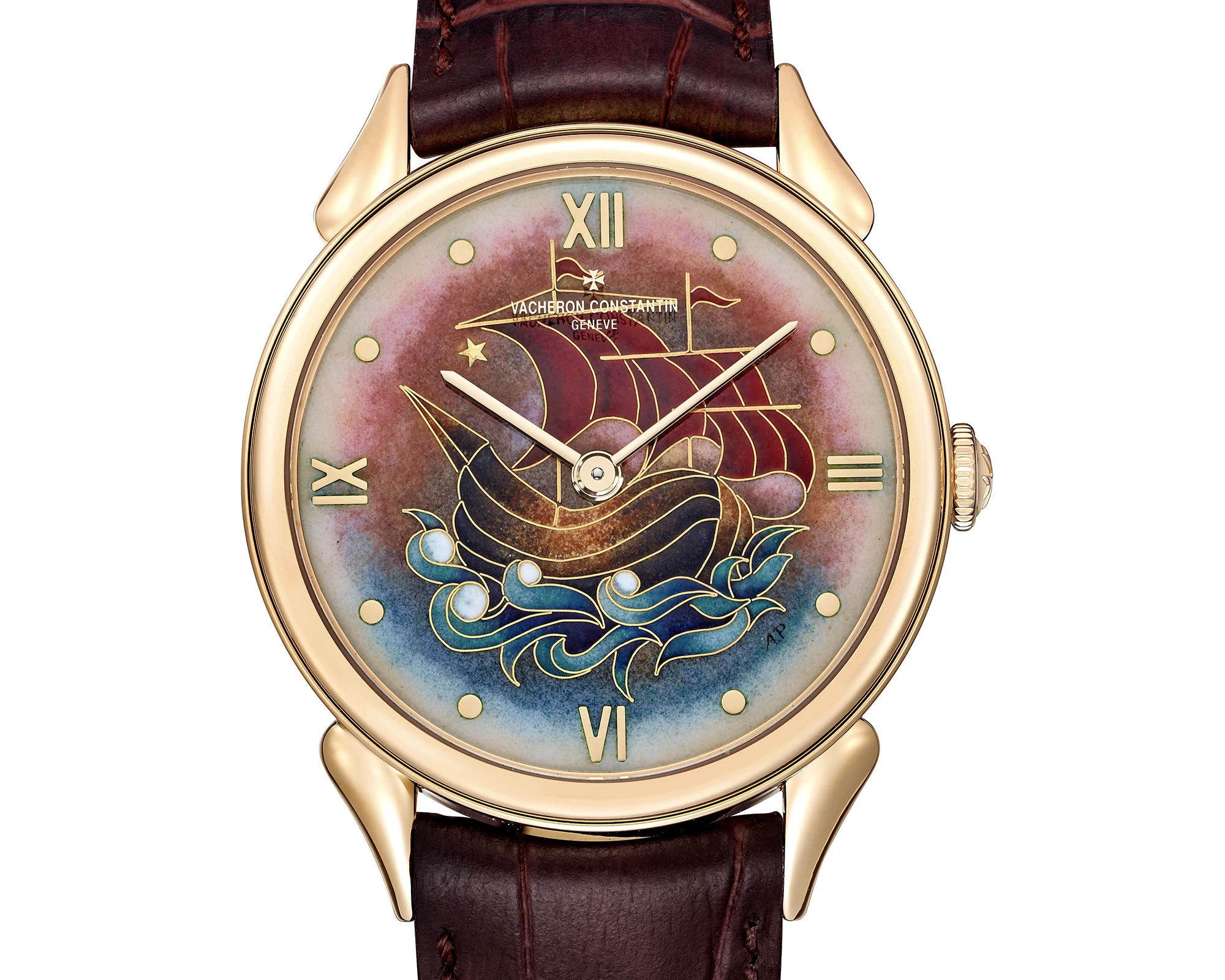

Finally, a bespoke Grand Complication pocket watch, ‘Les Cabinotiers –Tribute to J. Vermeer’, is worth mentioning, as its large cover is entirely enamelled in miniature painting – in the technique de Genève, as mentioned at the beginning.
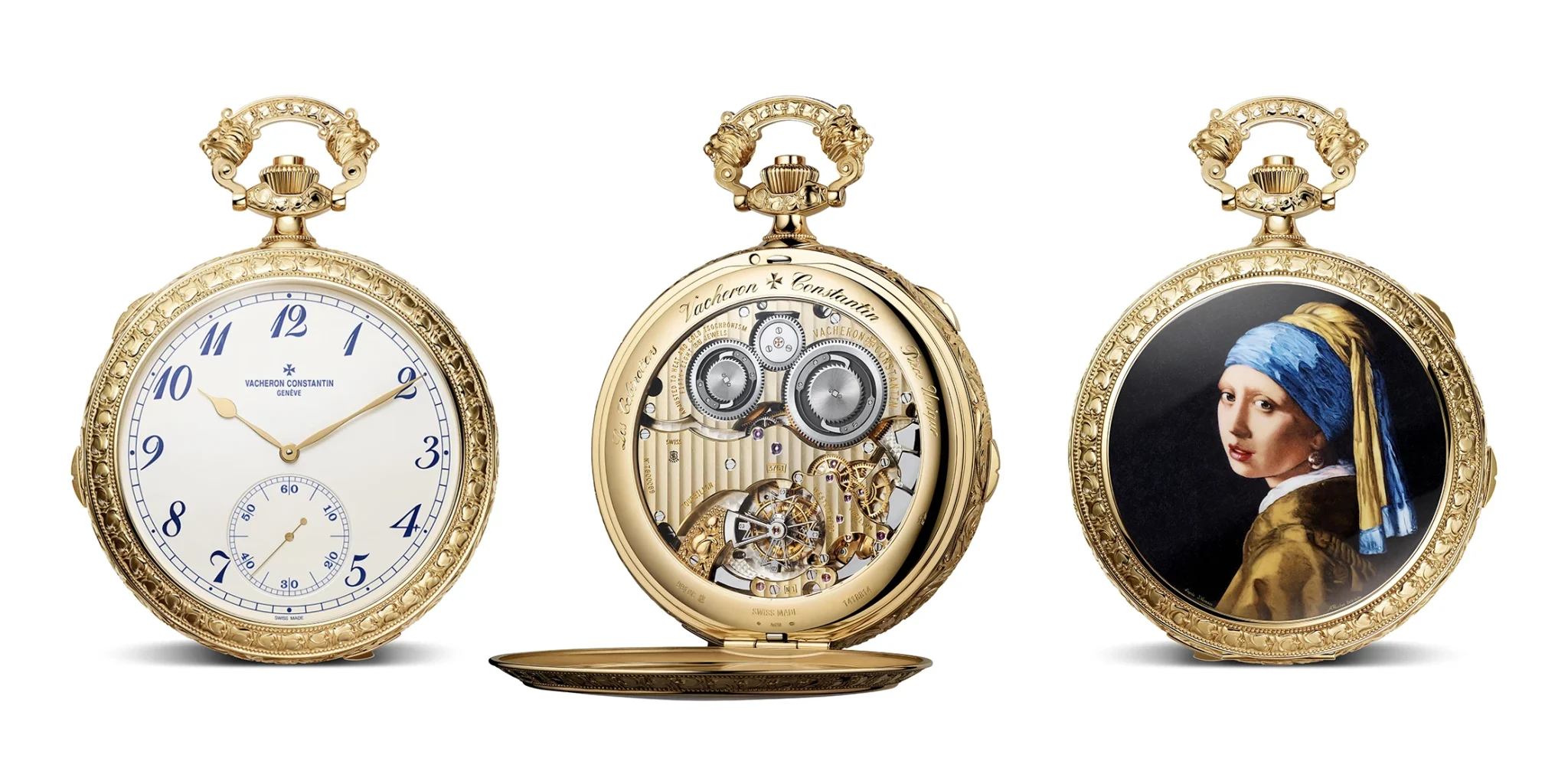
What is Geneva enamel?
As already mentioned, the Genevan enamellers developed the process that became known as Geneva enamel around 1780. It resembles a colourless glaze that protects the underlying layers of colour, making them even more radiant. Creating Grand Feu enamel, i.e. under a protective layer, is still quite challenging today, as there is always the risk of ruining the entire piece in a firing process.
Other outstanding models: thistles, close enough to touch
Early Vacheron Constantin pieces cover all facets of art. From simpler flowers and garlands on a gold-engraved base to decorations and tendrils that merge completely into the case and three-dimensionally wrap around it.
I will present a few more examples because they are so beautiful. In 1905, for example, the Geneva decorator and jeweller Bonnet-Chappuis created a pocket watch that the company presented at the Milan International Exhibition the following year. It is adorned with thistles in a cloisonné enamel technique on a black enamel background. Three years later, the same artist opted for a neo-Gothic decor in monochrome white enamel, leaving plenty of room for the gold of the caseback.
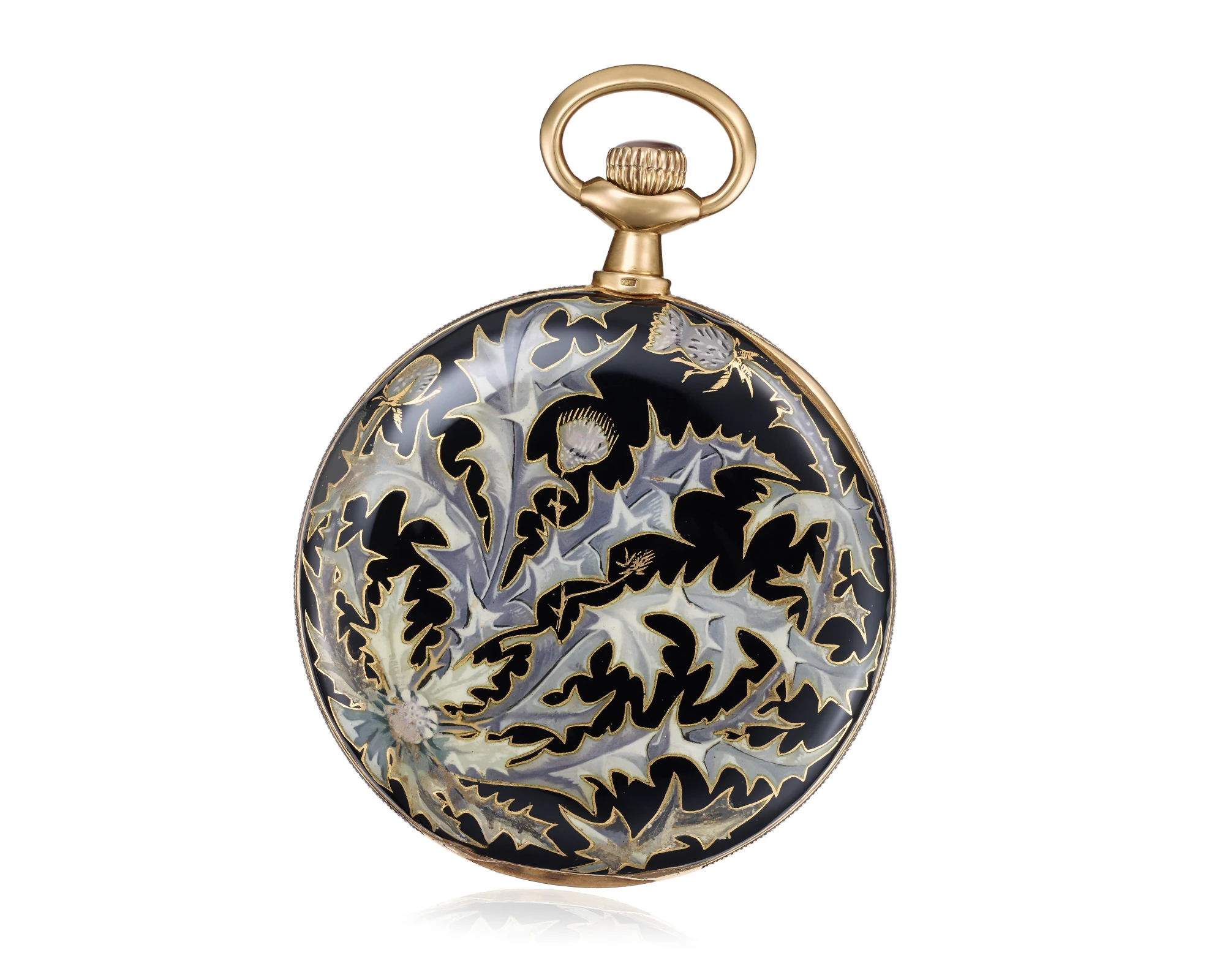
Two domed enamel creations from Verger Frères
A good two decades later, two creations, typical of the Art Deco style, by Verger Frères for Vacheron Constantin are released: the enamel appears to be slightly domed. This effect is achieved by the so-called drip technique, in which the last layer is thickened to make it convex. It is remarkable that the colours of the respective caseback extend to the bezel and are interrupted at the case shoulder by a fine blue enamel stripe on one watch and by an engraved gold border on the other.
Famous enamellers who have worked for Vacheron Constantin
For experts seeking to expand their knowledge: numerous artists have created sensational works on behalf of Vacheron Constantin, including master engraver Georges Oettinger. He applies coats of arms with rare precision onto casebacks. At the beginning of the 20th century, a certain Germain Pochon combined translucent enamel on a guilloché background with enamel miniatures. Furthermore, Jules Rosset and the sisters Marie and Louise Goll have been supplying the Maison with pieces in the 19th-century style for many years.
Dials and enamel work on Vacheron Constantin wristwatches
But let us turn to the currently most important display of enamel: dials. In principle, the enamelling of dials is no different from that of pocket watch cases. In the past, the numerals and minute scale were usually painted on with a single marten hair, until they were stamped on at the end of the 19th century. Crucially, throughout the 20th century, Vacheron Constantin upheld the legacy of these master artisans with an unwavering commitment to craftsmanship—a tradition exemplified by the works of Marthe Leclerc and Hélène May Mercier, created in collaboration with their mentor, Carlo Poluzzi.
Different dial enamel techniques that collectors should know about
Over the centuries, and in line with the tastes of the time, Vacheron dial makers have used every technique, from opaque white enamel to translucent gold dials with applied numerals, as well as tiny star, flower and arabesque motifs created with a guilloché punch made of gold or silver leaf. And, of course, the focus was always on enamel miniature painting and guilloché patterns.
Important Vacheron Constantin wristwatches with enamel dials
As early as 1943, the Maison’s main books mention numerous dials in the cloisonné and champlevé enamelling technique described above. The most popular subjects were representations of continents and specific places. North and South America were depicted, but there were also motifs such as Tahiti in 1947.
Sailboats and Mercator maps
In the mid-20th century, a sailboat at anchor or battling against the storm in the form of a caravel caused a sensation. The motifs go back to the Swiss painter Hans Erni. In 1970, the manufactore commemorated the flight of Apollo 14. And since 1996, it has been honouring the geographer and cartographer Gerhard Mercator, as Christian Selmoni mentioned at the beginning. The motifs were painted by Lucie and Jean Genbrugge. In 1997, Vacheron celebrated the scientist and painter John James Auduborn with a series of enamelled dials depicting birds (Muriel Sechaud and Anita Porchet). And finally, 25 years ago, the Chinese year of the dragon was celebrated accordingly.
The four seasons
For its 250th anniversary, Vacheron Constantin celebrated the revival of its Métiers d’Art with a collection themed around the four seasons, presented in four distinct models, each limited to just 11 pieces (with one set reserved for the company’s museum). The cases – depicting spring, summer, autumn, and winter – were crafted respectively in white gold, yellow gold, rose gold, and platinum. The dials feature Apollo’s chariot crossing the sky, rendered in seasonally shimmering hues using fine enamelling techniques, each employing a variety of methods.
We now turn to other important enamelling techniques that Vacheron Constantin – and only a select few maisons –continue to master today.
Miniature painting
At this point, miniature painting has already been mentioned several times, but we have not talked about its production process yet. As showcased by the ‘Métiers d’Art Chagall & L’Opéra de Paris’ watch series, this technique involves hand-painting the intended motif onto a pre-fire enamel layer. Each layer of colour is fixed by several firing processes to achieve vibrant shades. Finally, the entire piece is covered with a transparent layer of enamel to add brilliance and depth.
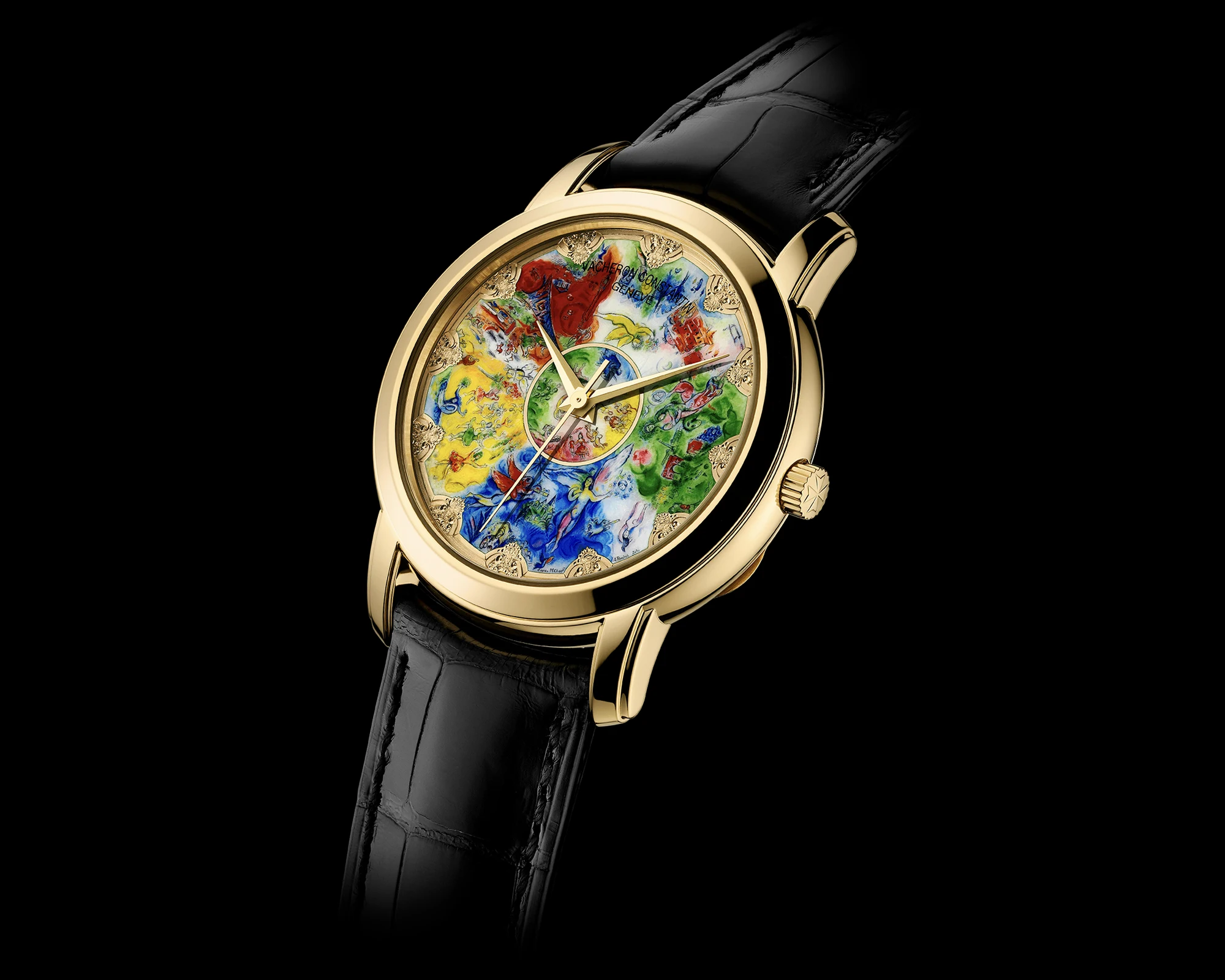
Grisaille enamel
The grisaille technique involves using a dark or black enamelled background on which the artisan creates a motif by successively applying Limoges white to achieve shades of grey and chiaroscuro effects. The artist works very freely, but must carve the motif out of the black. Conveniently, one of Vacheron Constantin’s master enamellers is from Limoges in France. Here, every second really does count, as each layer has to be fired with great precision, since too much heat can destroy the entire design. The finesse of Grand Feu grisaille enamel painting then reveals all the details, as in the ‘Métiers d’Art Hommage à l’Art de la Danse’ series, where even the slightest fold of the tutus, the velvety structure of a ribbon or the transparency of tulle are visible.
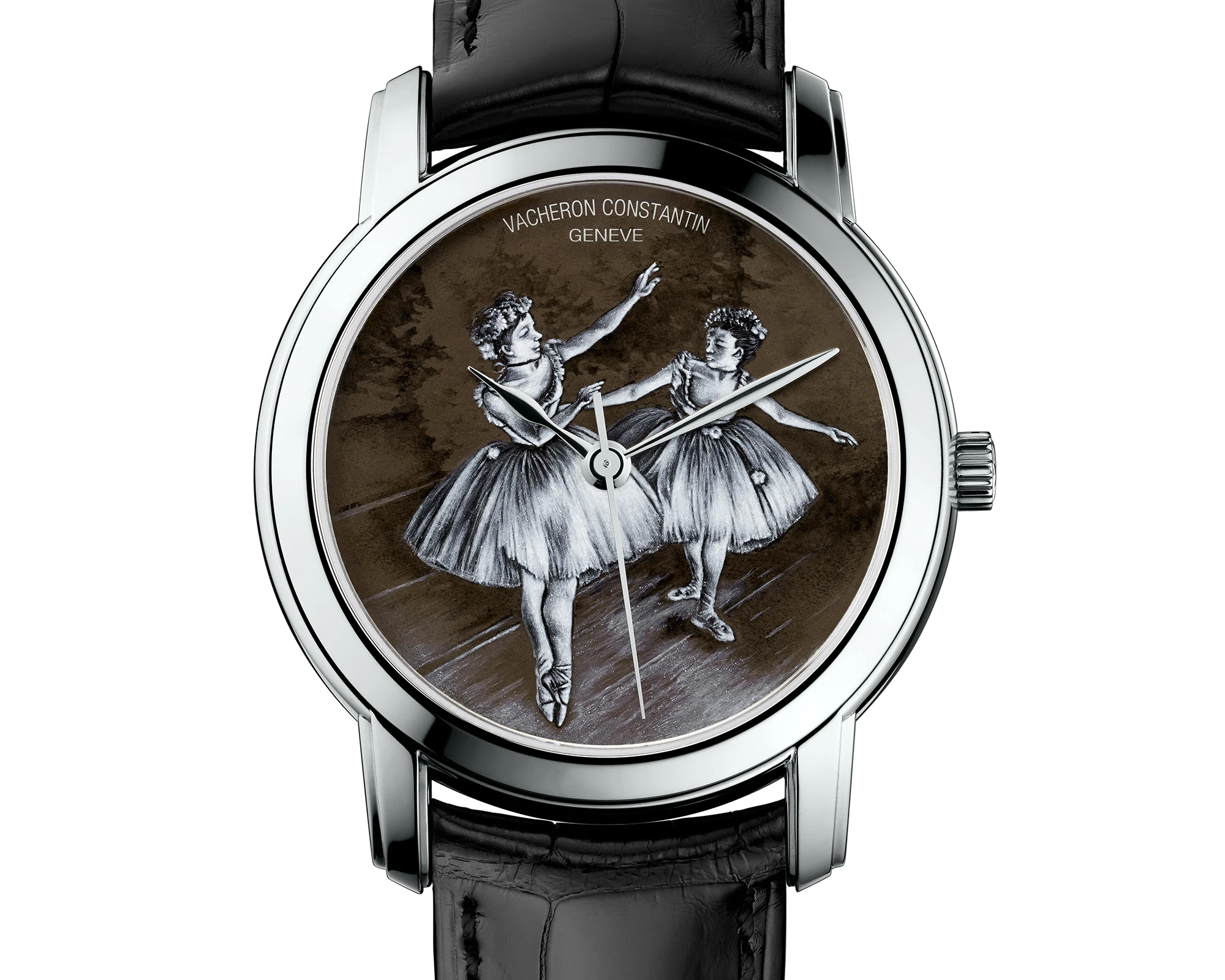
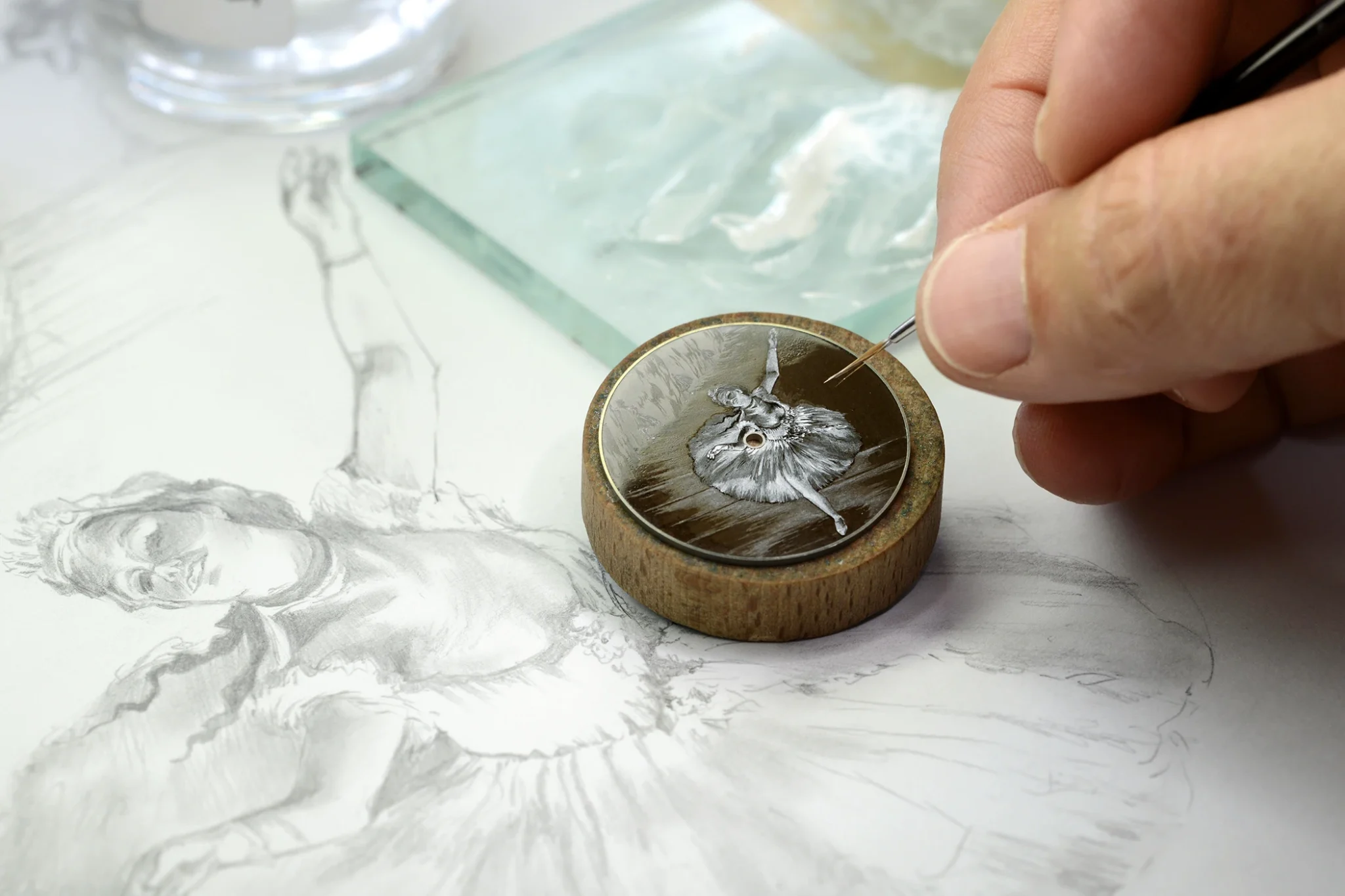
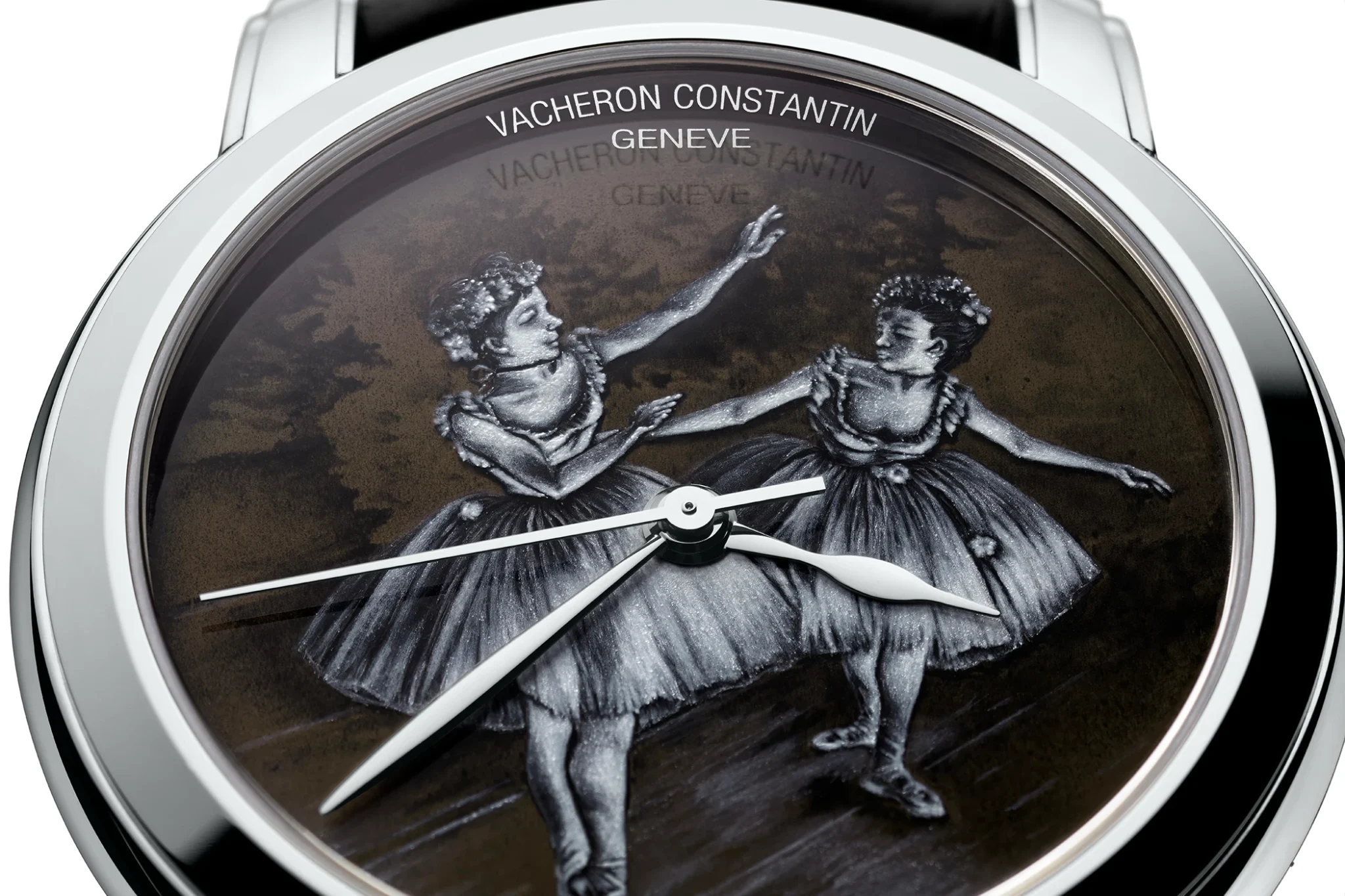
Plique-à-jour
This technique is a variation of cloisonné enamel, but it has no metal base in the finished state. The enamel is first applied to a thin copper base, which is dissolved with acids after firing. This results in a transparent effect reminiscent of stained glass windows. For example, this technique was used in the creation of translucent backgrounds for the ‘Métiers d’Art Les Aérostiers’ series.
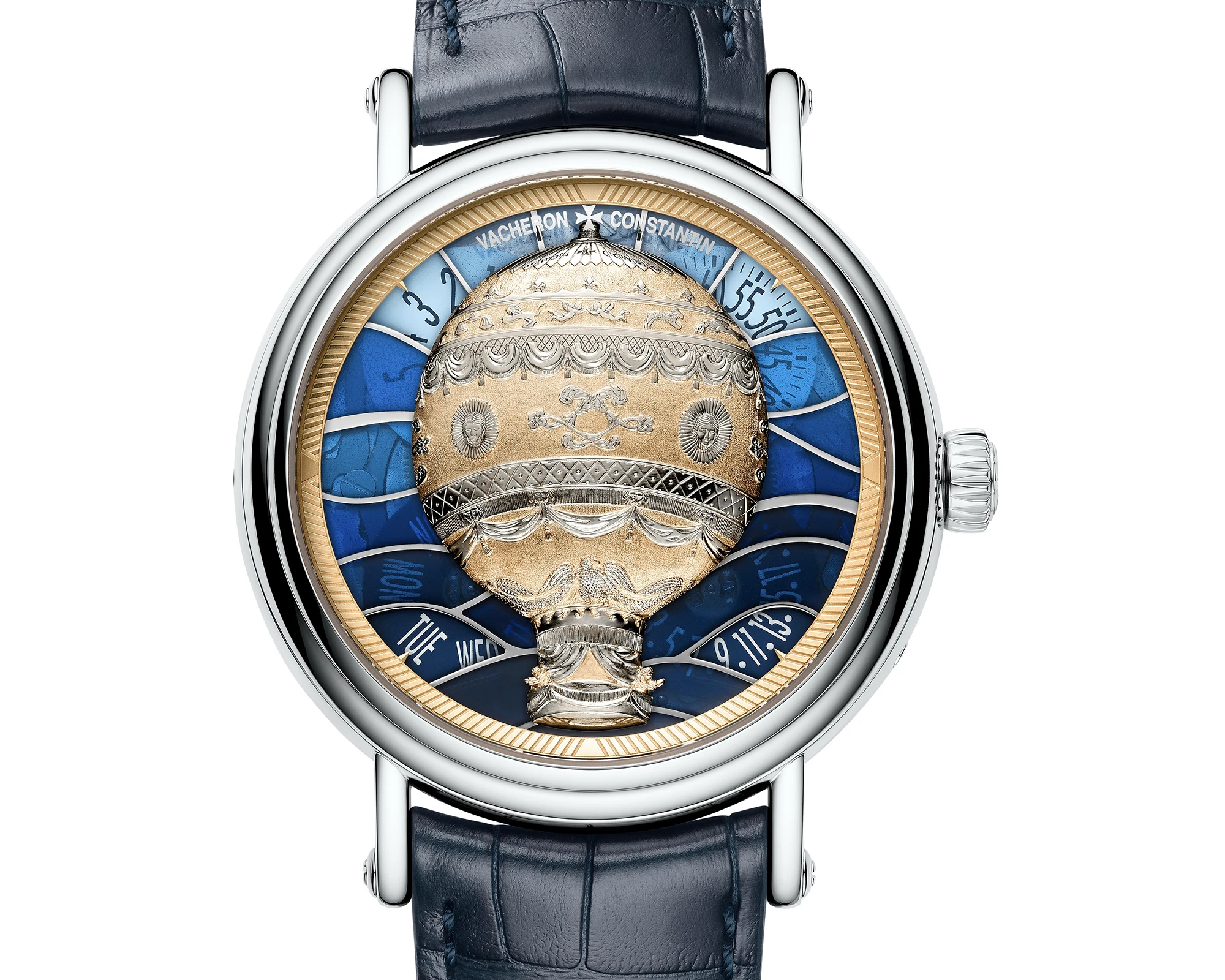
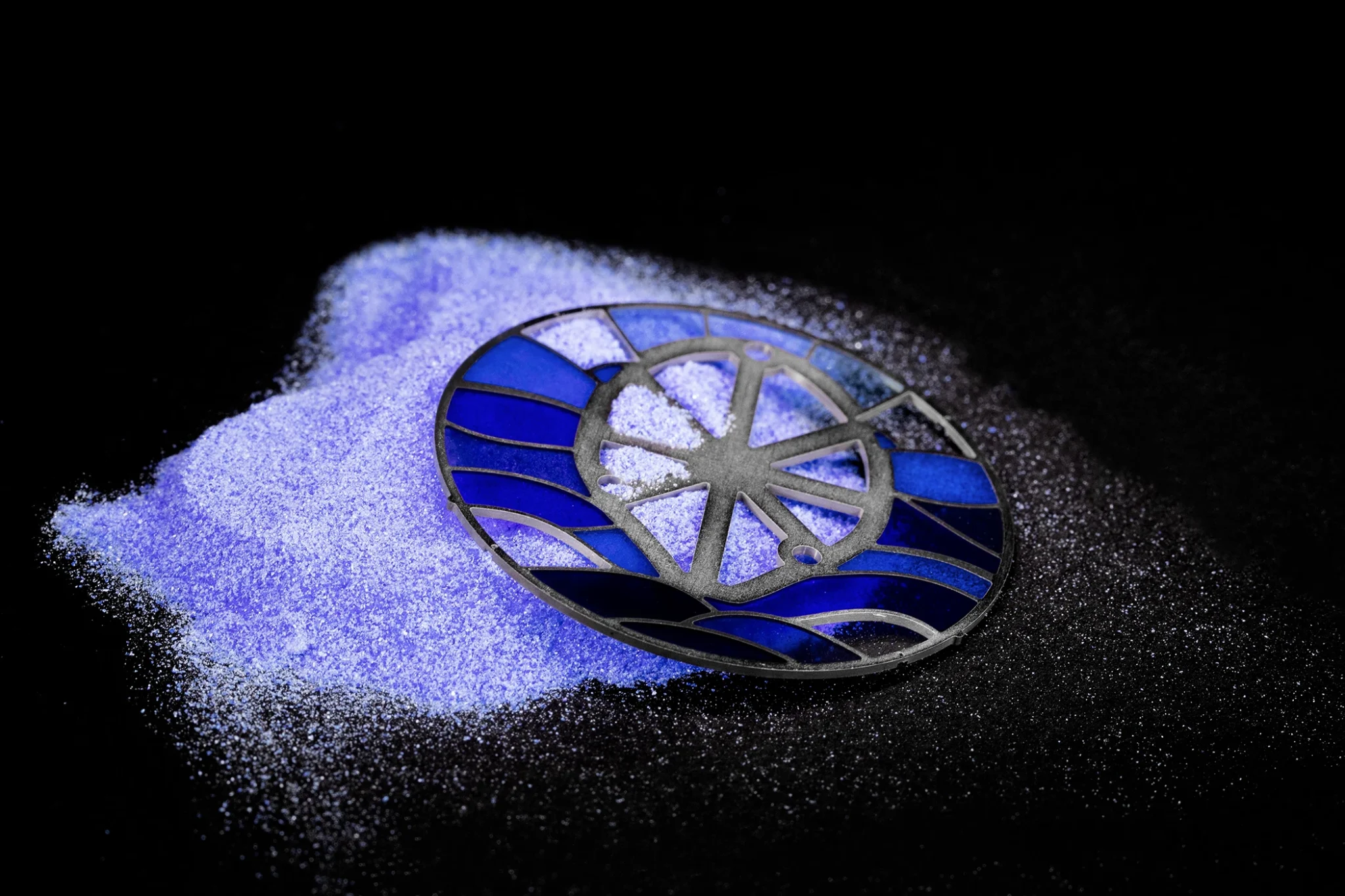
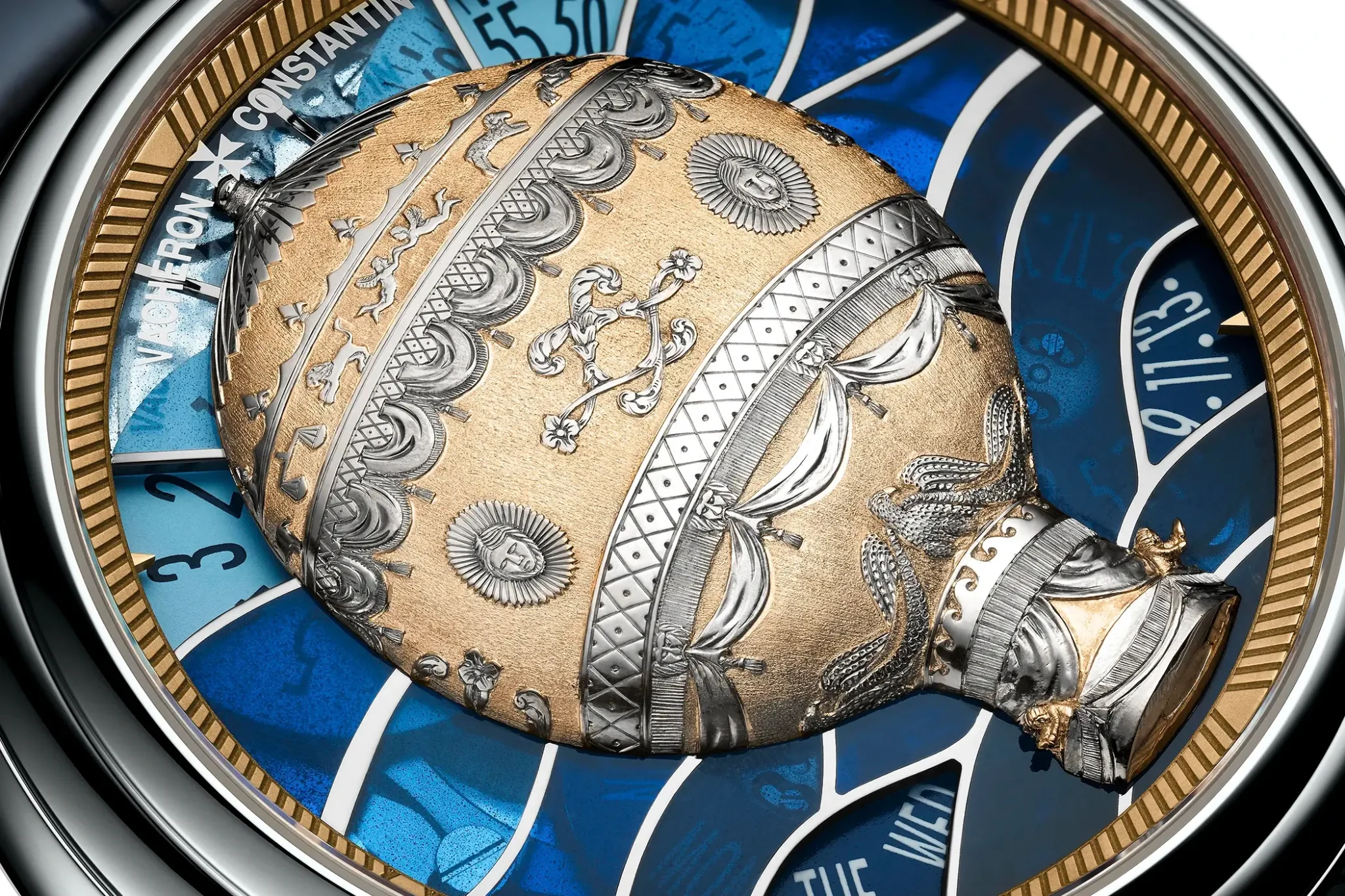
Flinqué enamel
Flinqué enamel involves covering a previously guilloché-decorated metal surface with transparent enamel to intensify the play of light in the guilloché structure. This is showcased in the ‘Métiers d’Art – Les Univers Infinis’ series, in which guilloché and cloisonné enamelling have been artfully combined.
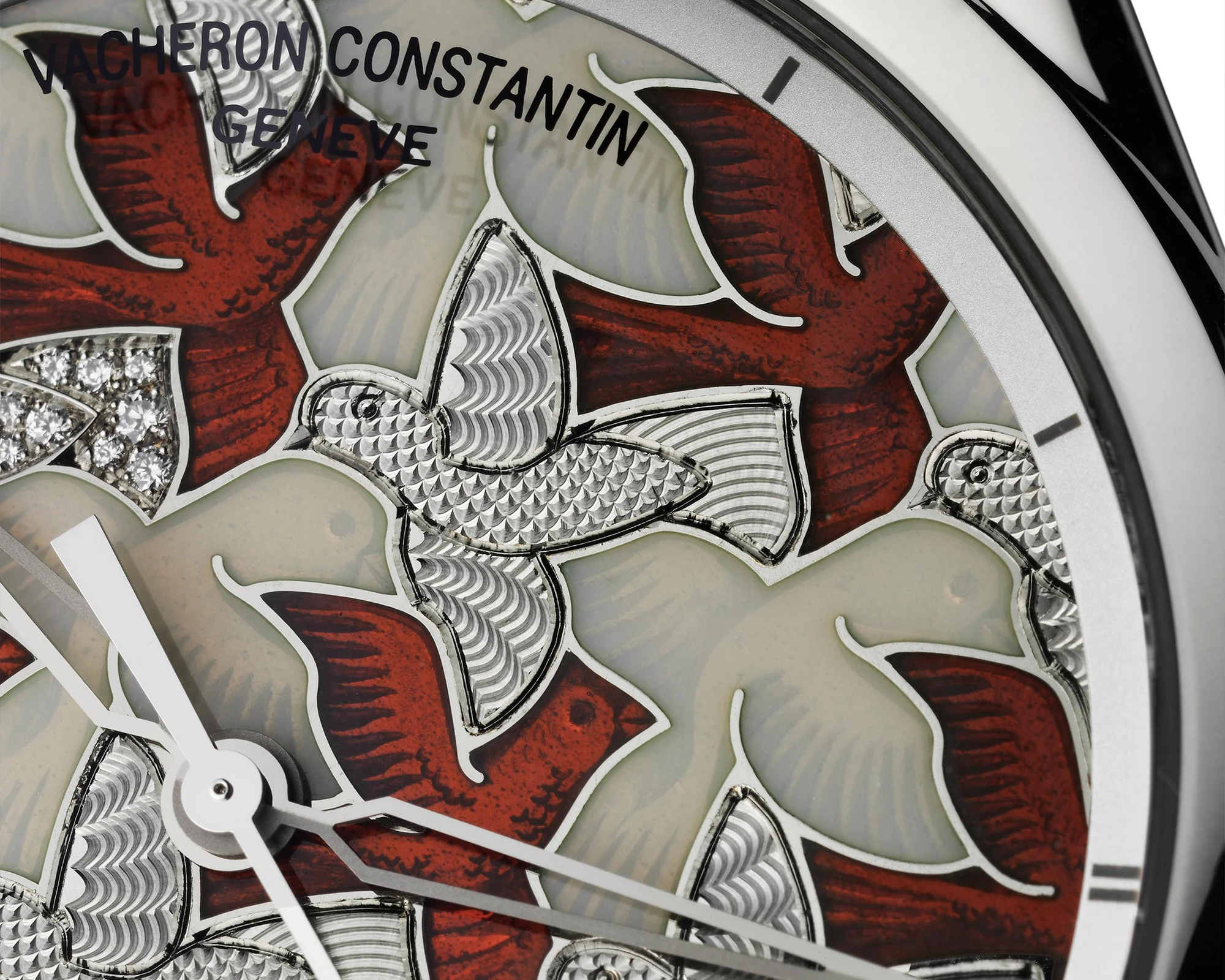
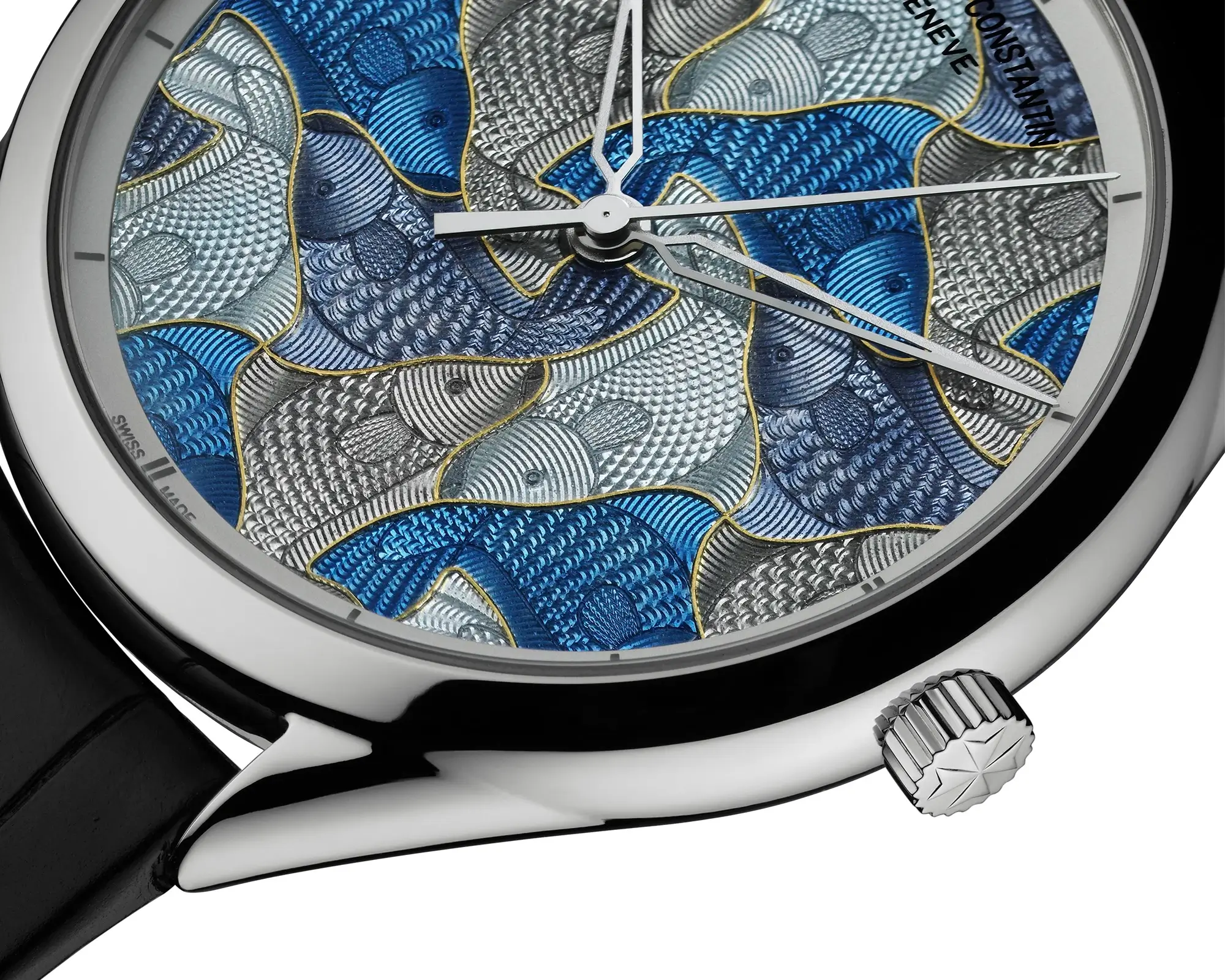
Tallow drop enamelling or drip technique
As briefly mentioned above, this method is often found in historical pocket watches and involves applying the enamel in several slightly domed layers to create a convex effect. While in cloisonné or champlevé enamelling, the enamel is often ground flat and then covered with a final layer of flux, in tallow drop enamelling, the top layer is deliberately left domed to maximise light reflections.
Which Vacheron Constantin watch was the first to have an enamel dial?
Which of the Maison’s pocket watches was the first to feature one of these enamel techniques? Selmoni admits: ‘That’s a really difficult question! Even if we have all the production registers of the Maison from the beginning, these crafts were not documented at the time. In our own collection, we have a pocket watch from 1785 that has a white enamel dial with enamelled Arabic numerals. It is a very impressive example of the extraordinary quality of early enamel work and its ability to stand the test of time. The dial looks like new because grand feu enamel never tarnishes or oxidises.’
Yellow gold pocket watch with enamel painting (1810)
This pocket watch from 1810 is the oldest enamelled piece with an enamelled case in the Vacheron Constantin collection, combining the art of engraving, guilloché, gem-setting, and enamel painting. The back of the gold case is decorated with a miniature painting of flowers, embedded in a landscape, surrounded by delicately chased gold arabesques, and studded with pearls, against a black enamel background.
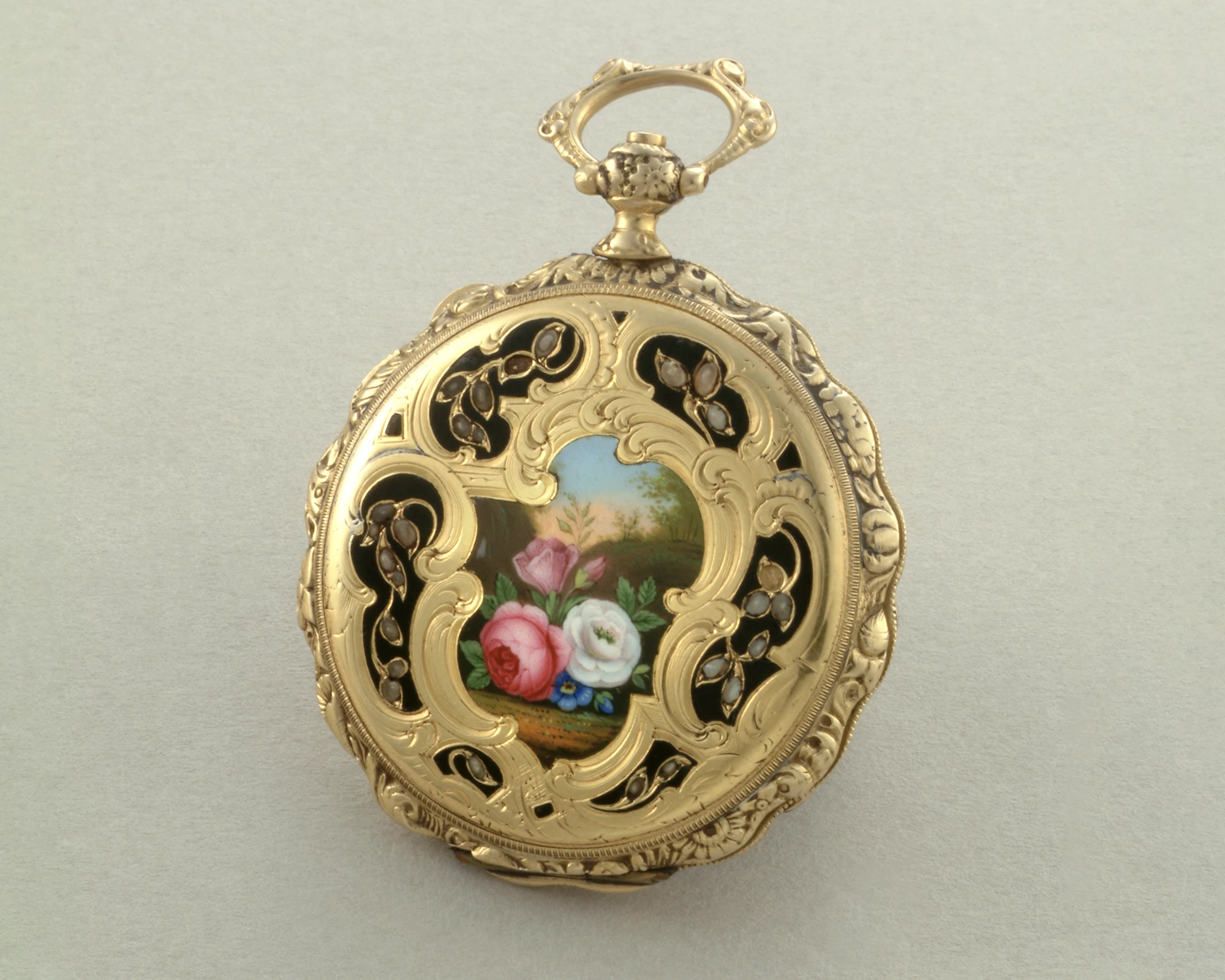
Miniature enamel and translucent enamel on a yellow-gold pendulum clock (1908)
This type of watch is worn on a necklace made of yellow and white gold, diamonds, and pearls. The case is decorated with transparent enamel on an engine-turned background, showing a miniature-painted floral motif and additional florally shaped appliques in platinum and diamonds.
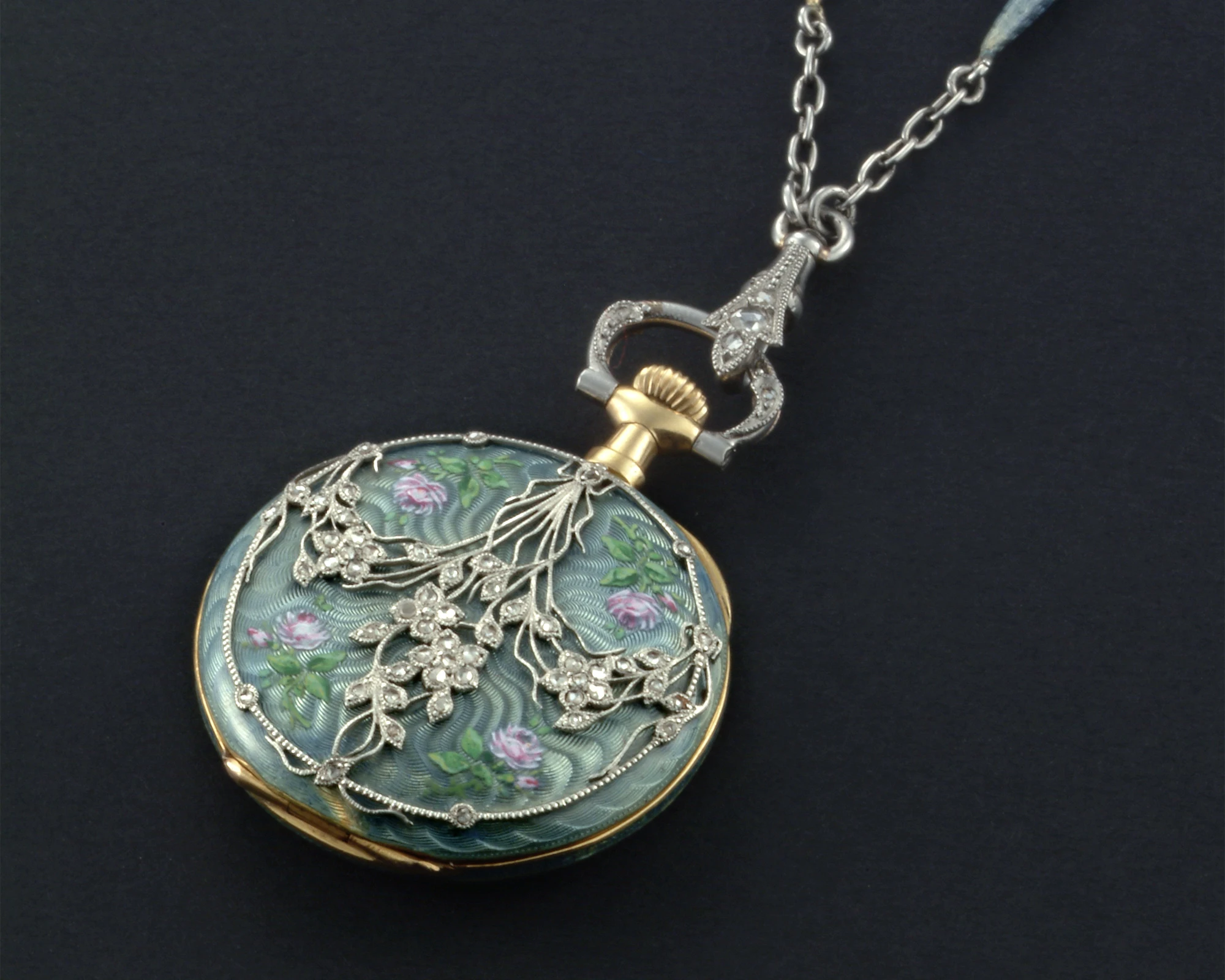
Egérie Creative Edition, black enamel (2022)
Inspired by Burano lace, this white gold watch combines four artistic crafts, including the difficult black enamel. Due to its properties, black is the most challenging enamel colour to achieve, as even the smallest imperfections or bubbles become visible. The black enamel is applied over a tapestry pattern to create a strong contrast and a three-dimensional effect.
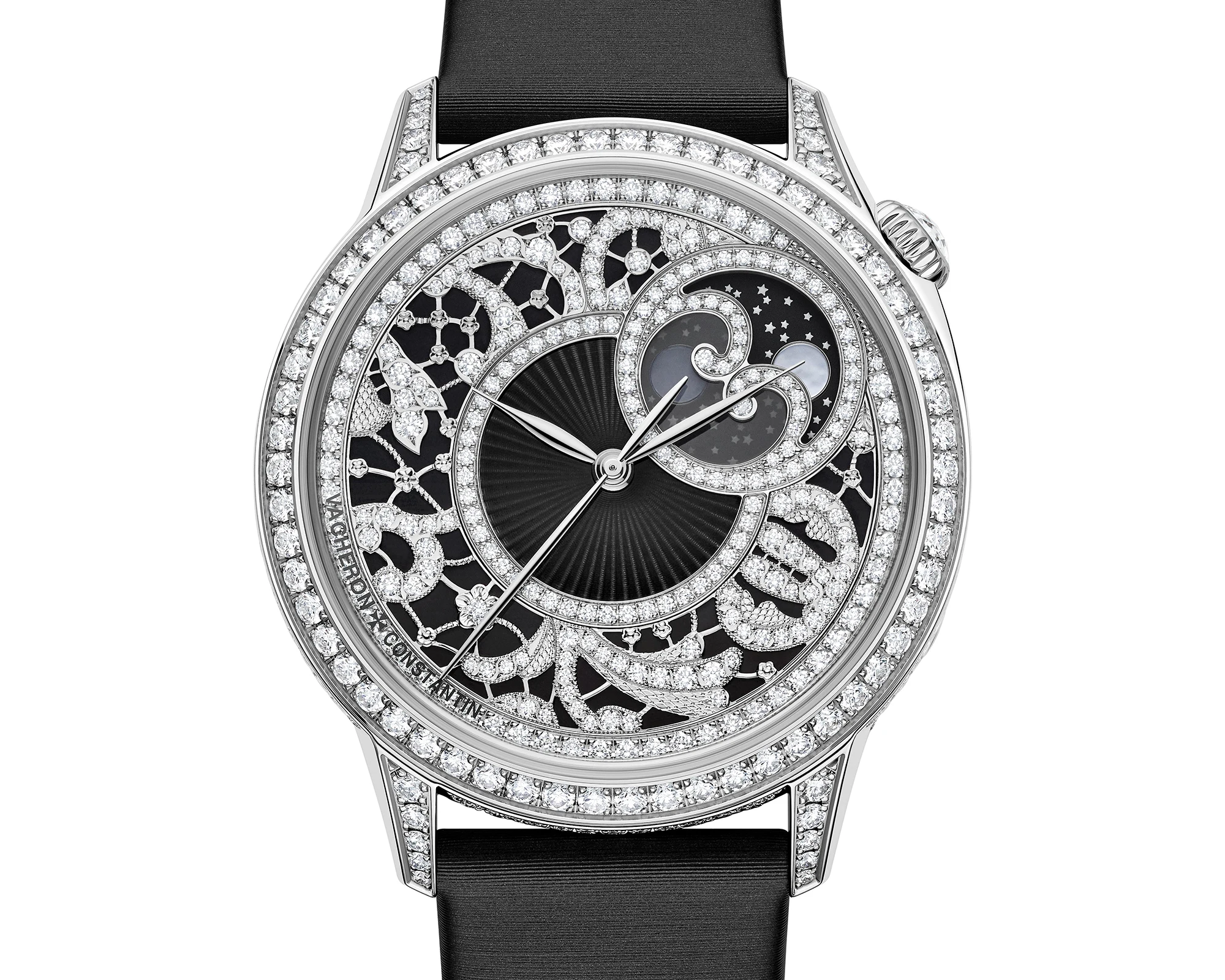
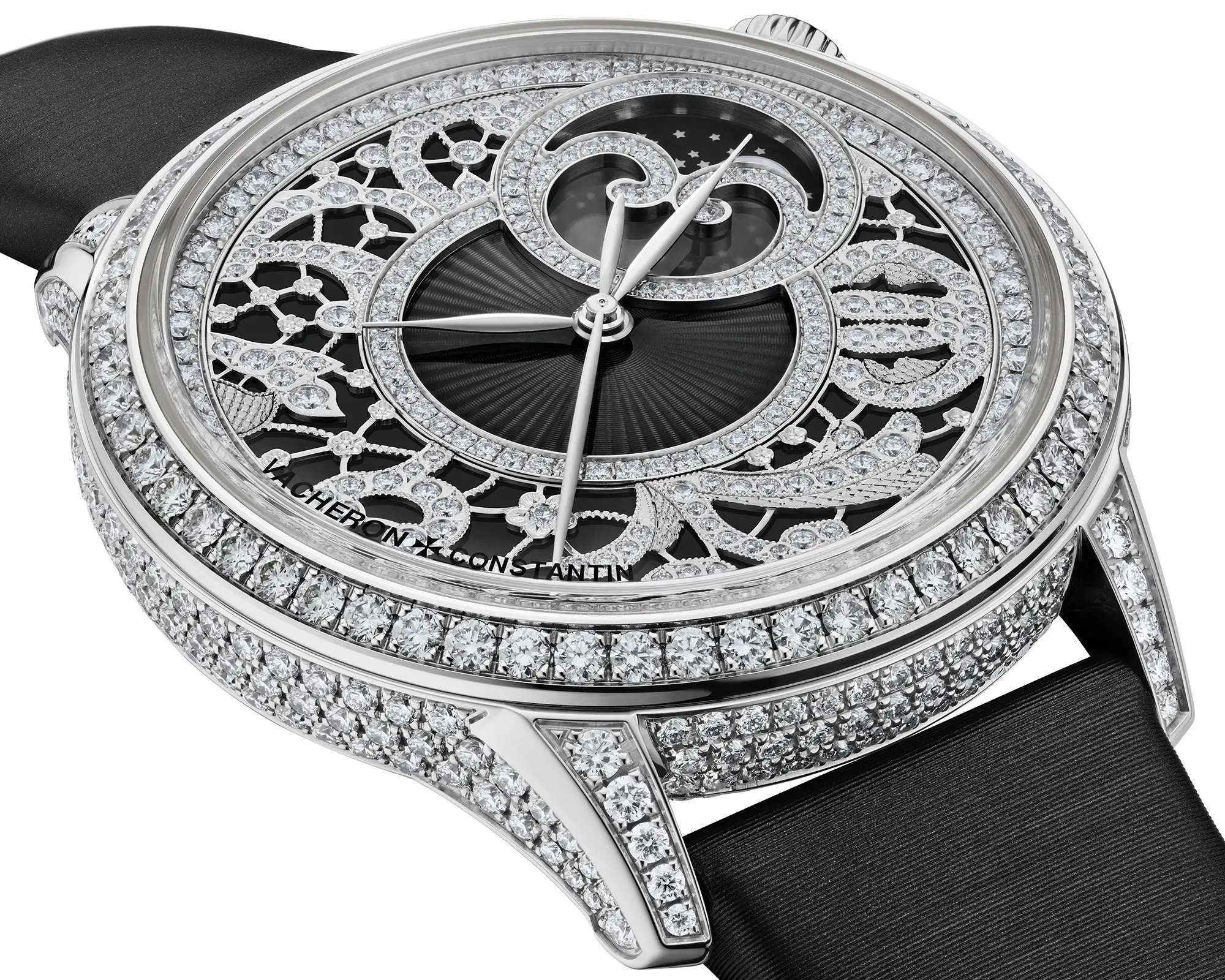
Métiers d’Art Fabuleux Ornements – Indian manuscripts (2014)
This series pays tribute to decorative art forms from around the world and comprises four models that combine different crafts. A dozen master craftsmen took turns to create Ottoman architecture, Chinese embroidery, French lace, and Indian manuscripts. The dials were made using the champlevé technique and show oriental floral motifs on a blue sky background with a skeletonised movement.
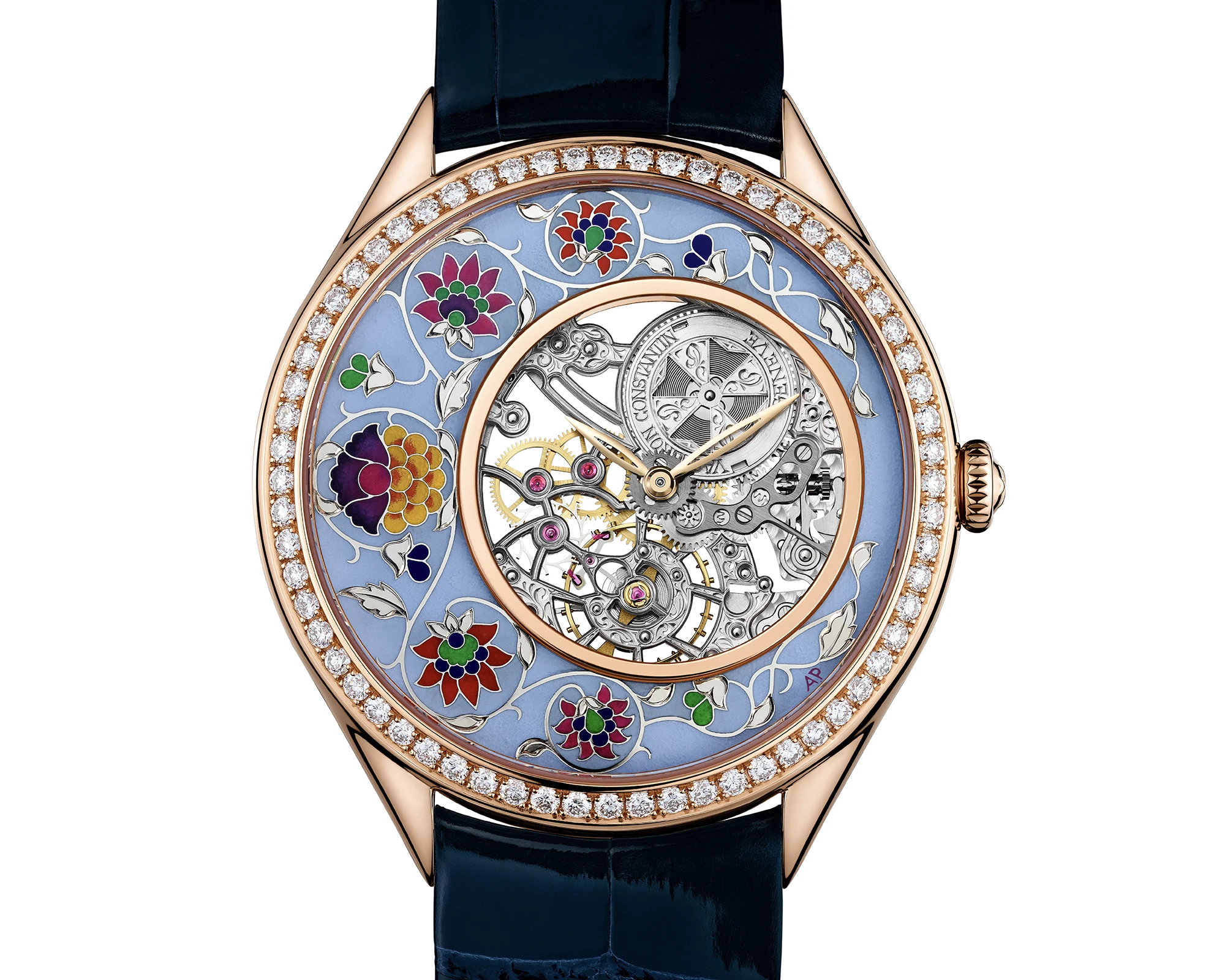

Les Cabinotiers Minute Repeater Tourbillon – Flying Dutchman (2022)
This unique piece pays tribute to the legend of the cursed captain that inspired Richard Wagner. The raging sea under a full moon interspersed with lightning was created using traditional Geneva enamel miniature painting. In a second step, the ghostly ship was added in grisaille enamel, with light and shadow effects perfectly capturing the fantastical atmosphere of the legend.


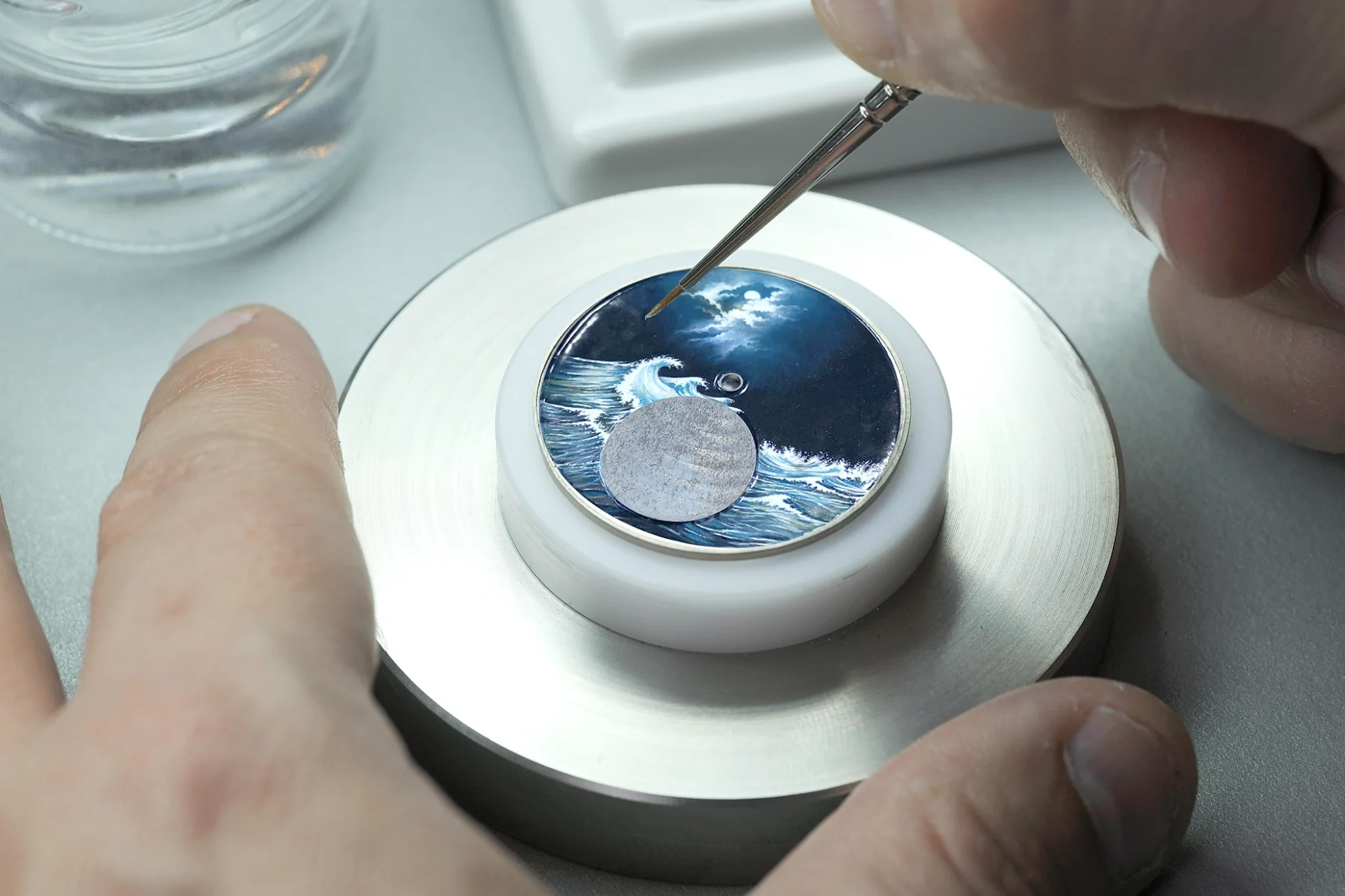
Vacheron Constantin ‘La Musique du Temps’ (2020)
This minute repeater watch with artistic cloisonné enamel on the dial was sold at Christie’s for an undisclosed sum and is considered one of Vacheron Constantin’s most artistic enamelled models.
Arts and crafts where Haute Horlogerie is a matter of course
Have you noticed something? Not once have we talked about the movement. Why? Because there’s no need. Who would create a miniature painting with a Grand Feu enamel dial, involving countless steps, for a wristwatch that is insignificant or has a basic movement? That’s right, no one. Even if the enamel work on modern watches is perhaps not to everyone’s taste, it automatically fulfils an important criterion for collectors: the extremely high proportion of handwork involved makes them rare, and the diversity of each painting means that they are almost always unique. As we learned at the beginning, what once served as a precious burial gift can now be worn and cherished on the wrist for a lifetime. And, as countless auction results show, these timepieces often continue their journey in the hands of future collectors or heirs – lasting well beyond a single lifetime. By choosing a mechanical wristwatch with an enamel dial, collectors become part of a legacy that has captivated discerning owners for centuries. So rather than paying astronomical sums for mass-produced steel models – and risking becoming a grand fou (a fool) –perhaps it’s time to spark a different kind of passion and turn to the brilliance of grand feu enamel.
